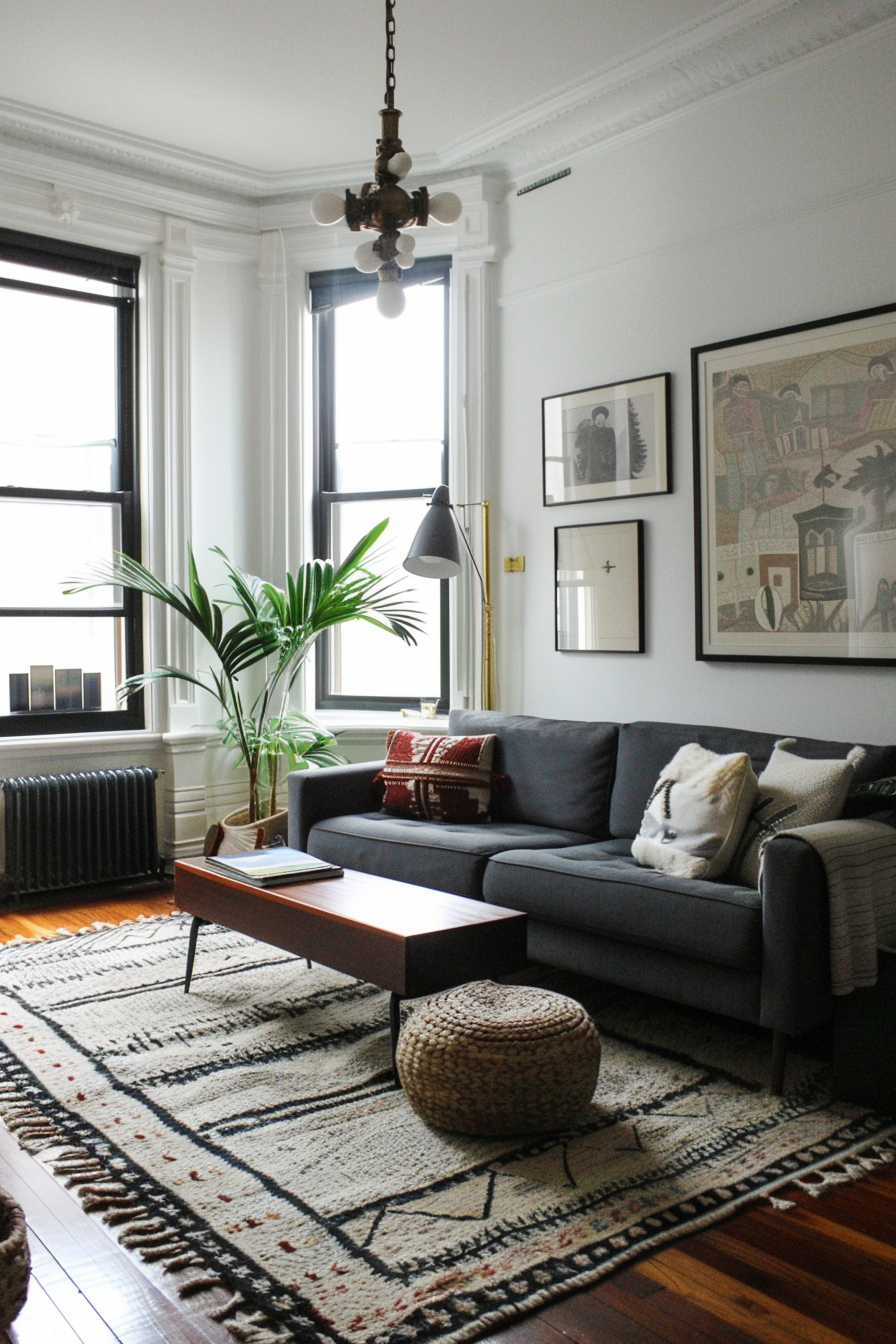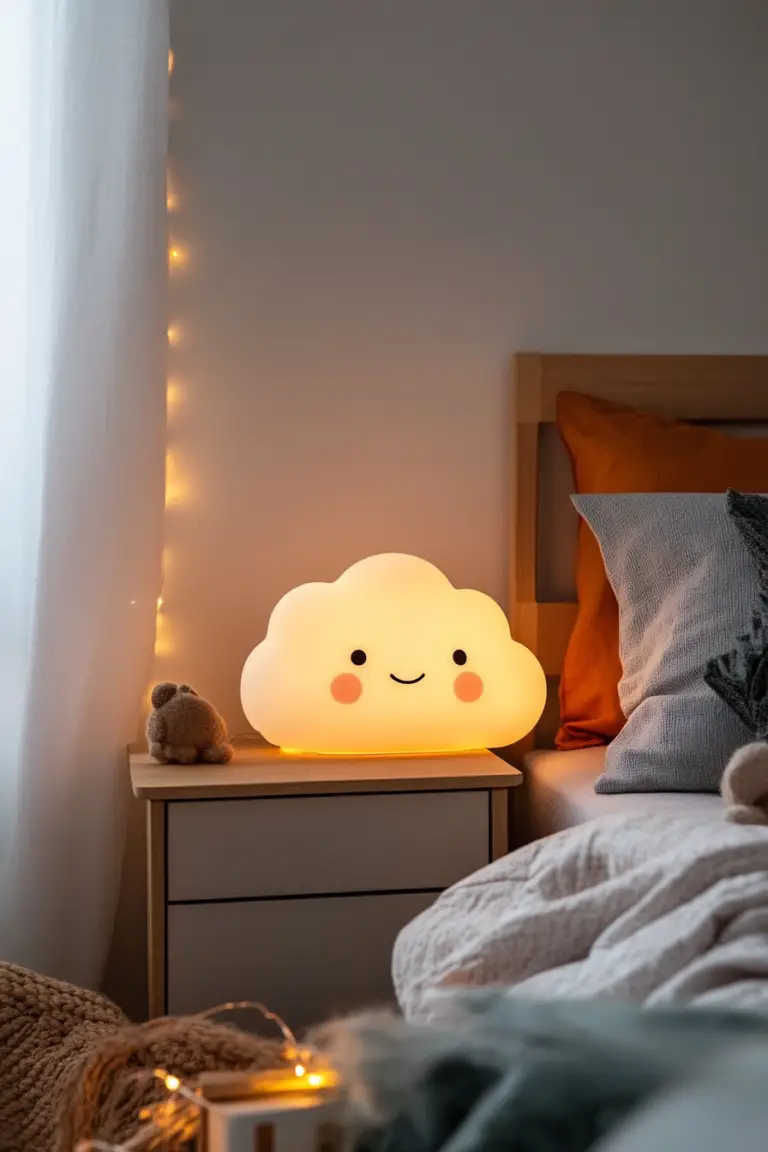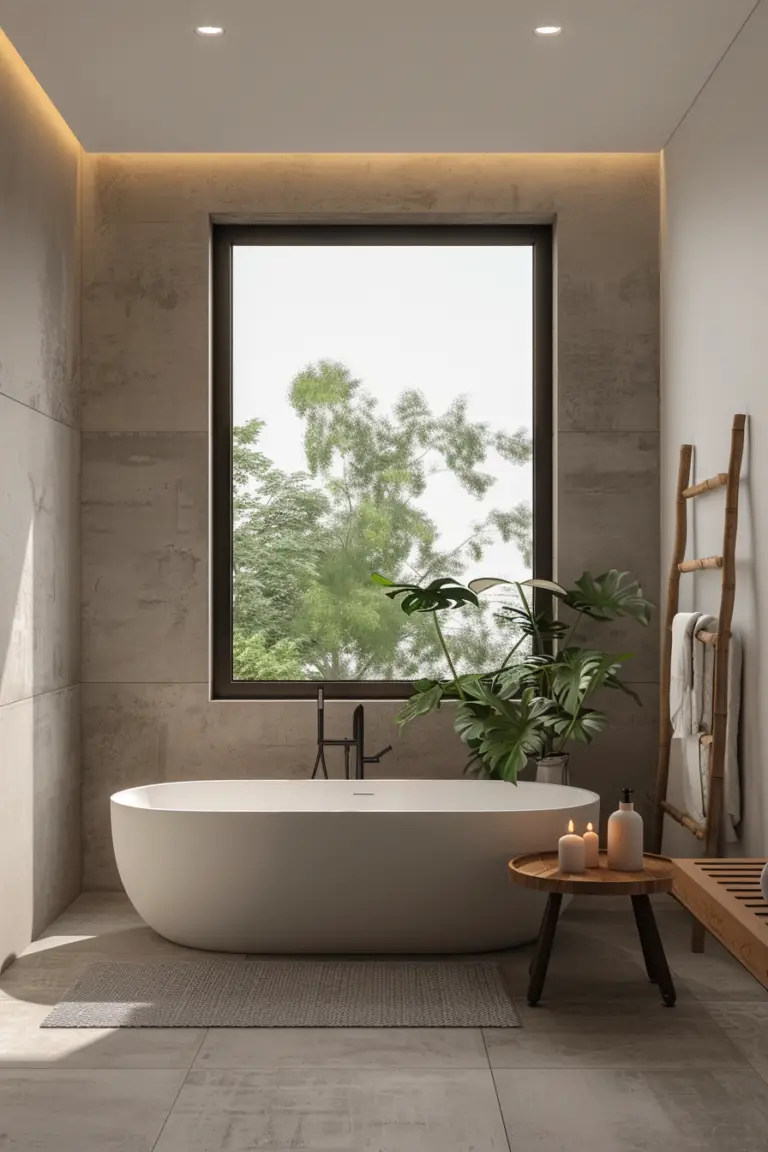How to Craft an Organic Modern Living Room
Did you know that the sleek, minimalist spaces you admire can also be warm and inviting?
That’s the magic of the organic modern living room—a style that seamlessly blends the simplicity of modern design with the cozy vibes of natural elements. If you’ve ever thought modern décor feels too cold or organic styles are too rustic, this trend is about to change your mind!
What Exactly Is Organic Modern Style?
Imagine walking into a room where clean lines meet earthy textures, and minimalist furniture is paired with lush greenery. Organic modern style is all about balance—it brings together the best of both worlds by combining contemporary design with natural materials. It’s like inviting nature over for coffee in your chic, modern space!
Key Elements to Nail the Look
Natural Materials
Incorporate materials like wood, stone, and leather to add warmth and texture. Think reclaimed wood coffee tables or stone accent walls that make a subtle statement.
Neutral Color Palette
Stick to shades of white, beige, gray, and taupe as your base. Then, sprinkle in some earthy tones like olive green or terracotta for a pop of color.
Minimalist Design
Less is more! Opt for furniture with clean lines and avoid clutter to keep the space feeling open and airy.
Cozy Textures
Layer soft textiles like wool throws, linen cushions, and plush rugs to add depth and comfort to your living room.
Indoor Plants
Bring the outside in with plenty of greenery. Plants not only purify the air but also add a vibrant touch to your décor.
Tips to Bring Organic Modern Style Into Your Home
- Swap out synthetic rugs for natural fiber ones like jute or sisal.
- Opt for furniture made from sustainable materials.
- Get crafty and make your own wall art using pressed flowers or leaves (it’s fun and budget-friendly!).
- Embrace imperfection by choosing items with natural flaws—it’s what gives them character.
- Let there be light: Use sheer curtains to maximize natural light.
Budget-Friendly Hacks and DIY Ideas
Who says you need a big budget to revamp your living room? Here are some wallet-friendly tips:
- DIY Floating Shelves: Use reclaimed wood to create floating shelves. They’re perfect for displaying plants or décor items.
- Second-Hand Finds: Visit thrift stores or online marketplaces for unique pieces that add charm without breaking the bank.
- Paint It Yourself: A fresh coat of paint in a neutral tone can instantly modernize your space.
- Upcycle Old Furniture: Sand down and refinish that old coffee table to give it a new lease on life.
Quick Tips to Pull It All Together
- Mix and Match: Don’t be afraid to combine different textures and materials.
- Stay Neutral: Keep the color palette simple for a cohesive look.
- Declutter: A clutter-free space is key to achieving that minimalist vibe.
- Personalize: Add personal touches like family photos in simple frames.
- Balance is Everything: Strive for a harmonious blend of modern and organic elements.
1. Start with a Neutral Color Palette
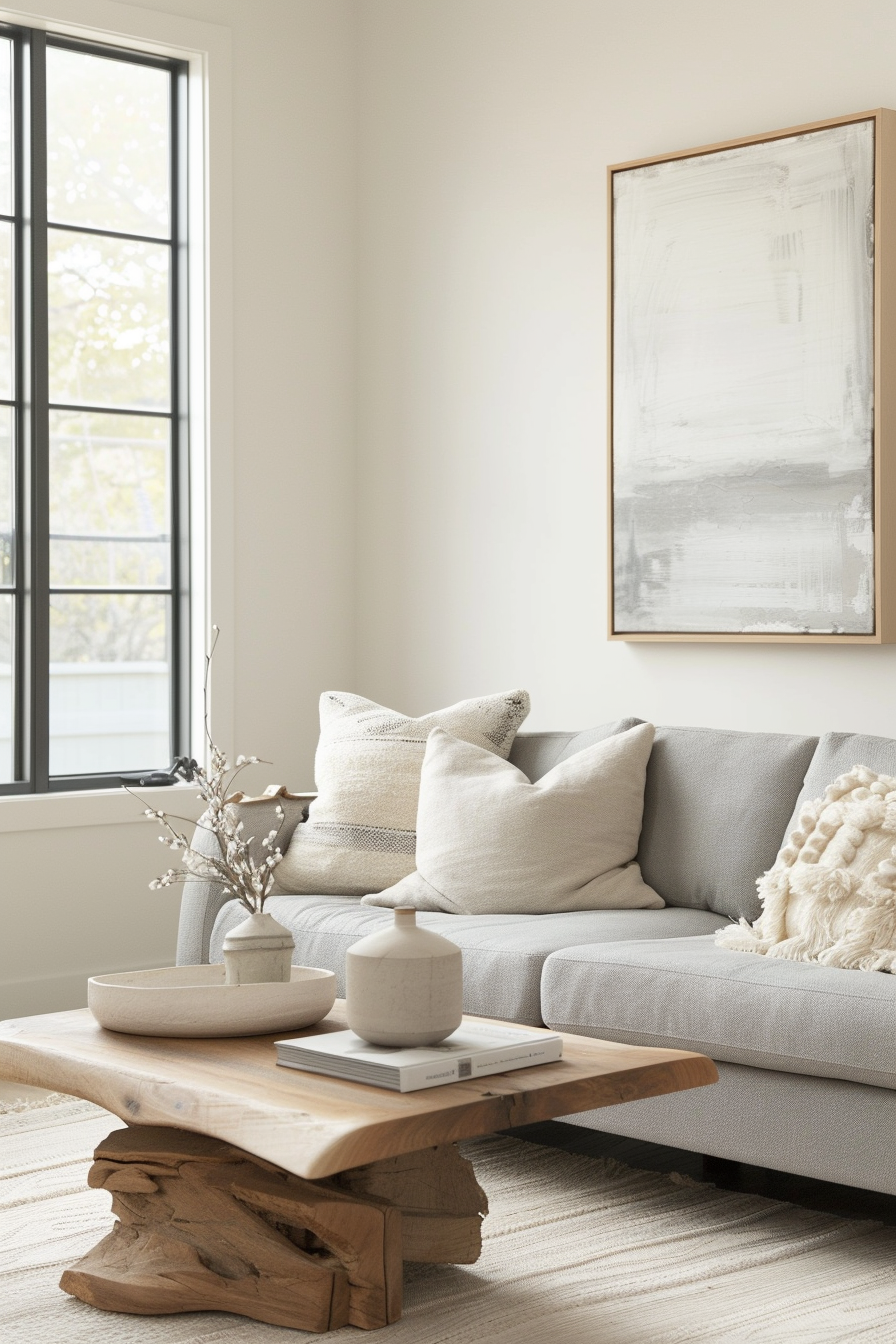
Organic modern design relies on a foundation of neutral colors, which provide a calming backdrop and allow the natural elements of the decor to shine. Think shades of white, beige, taupe, and gray. These colors create a harmonious and versatile base that can easily be adapted with various textures and accents.
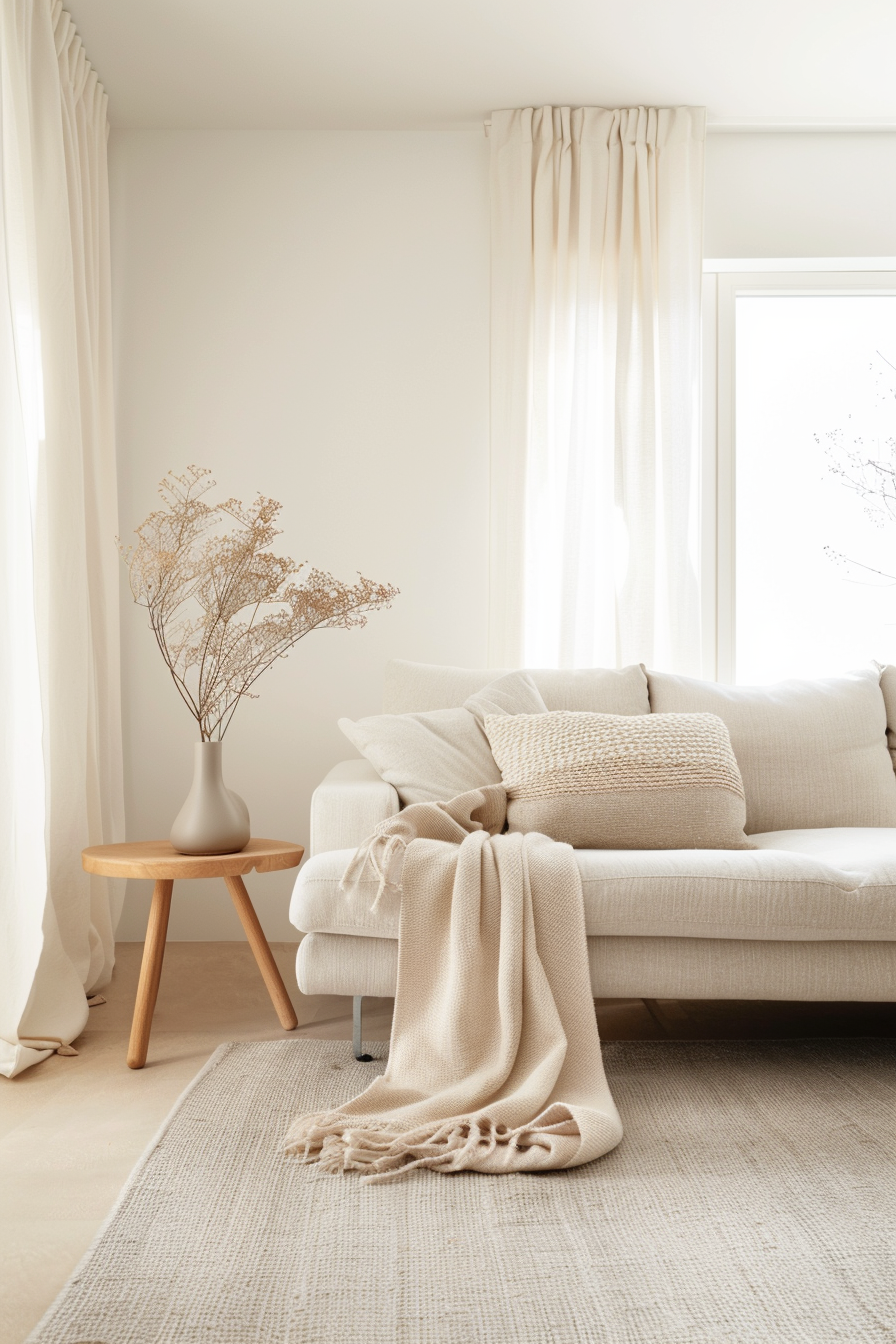
Layering different shades of neutral colors adds depth and dimension to the room without overwhelming it. For example, a soft beige wall paired with a gray couch and white accents can create a serene environment. Incorporate subtle variations within the same color family to maintain interest and avoid a flat appearance.
Adding natural materials such as wood, stone, and organic textiles will enhance the palette’s warmth and texture. Consider a light wood coffee table or a woven rug to complement your neutral tones. These elements not only add visual interest but also help connect the space to nature.
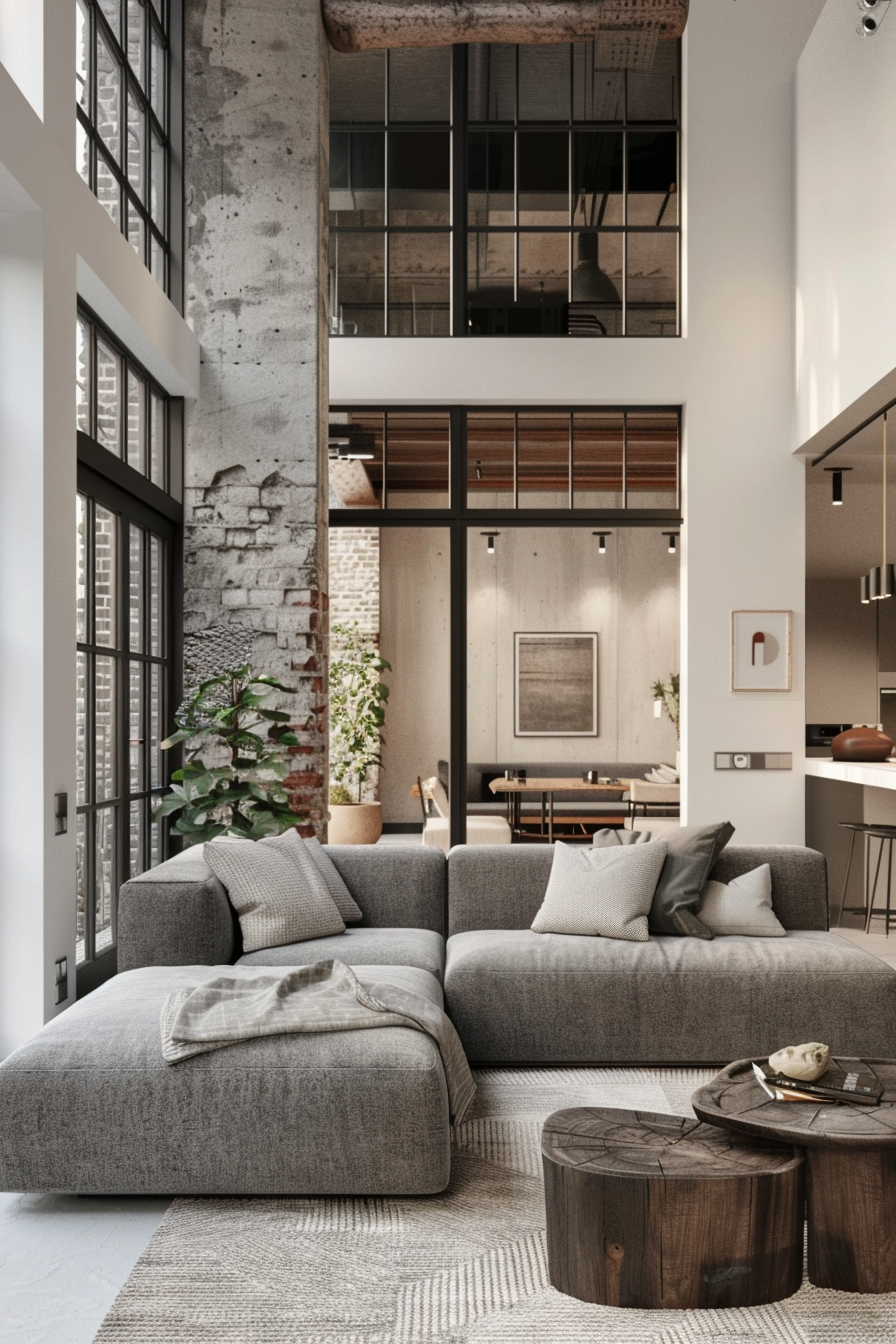
2. Choose the Perfect Rug
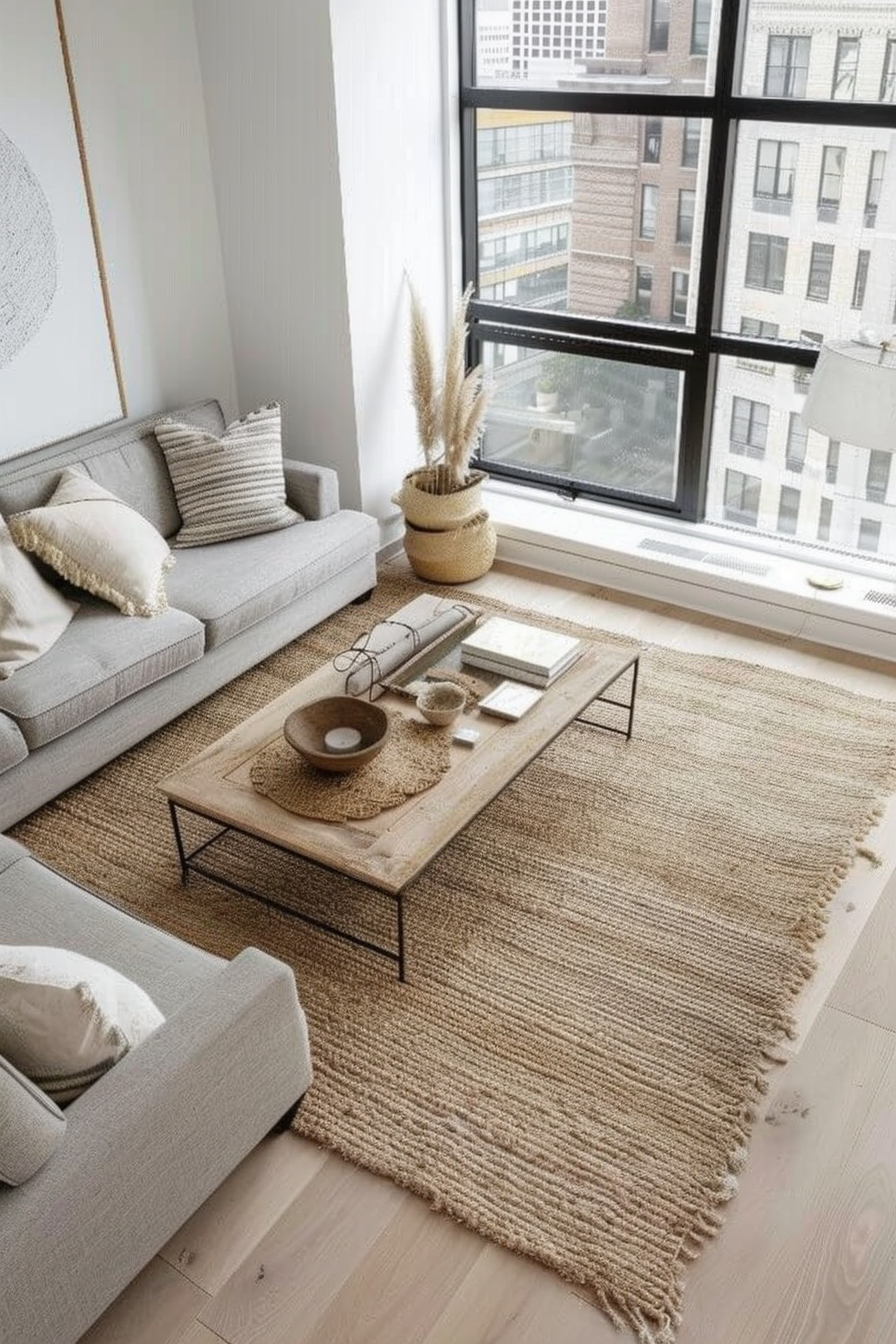
The right rug can anchor your living room and pull together the elements of your organic modern design. Look for natural materials such as wool, jute, or sisal, which add texture and a touch of nature to the space. These materials are not only durable but also bring a sense of warmth and comfort.
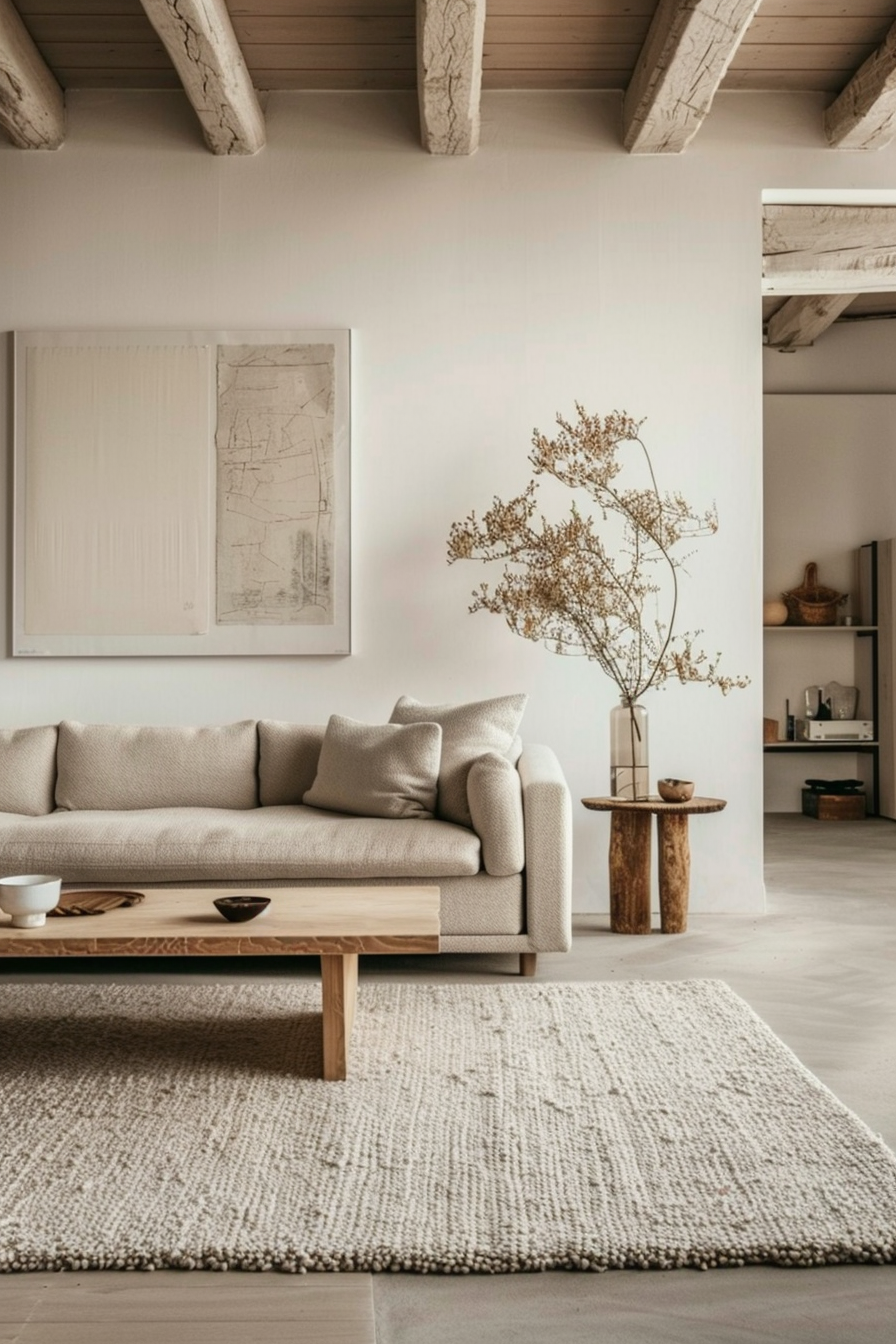
Opt for rugs in neutral tones or subtle patterns that complement your color scheme. A handwoven jute rug, for instance, can provide a rustic yet refined touch. If you prefer something softer underfoot, a plush wool rug in a light, earthy shade would be an excellent choice.
The size of the rug is crucial, especially in small spaces. Ideally, it should be large enough to fit all your furniture or at least the front legs of your seating arrangements. This helps define the area and makes the room feel more cohesive and inviting.
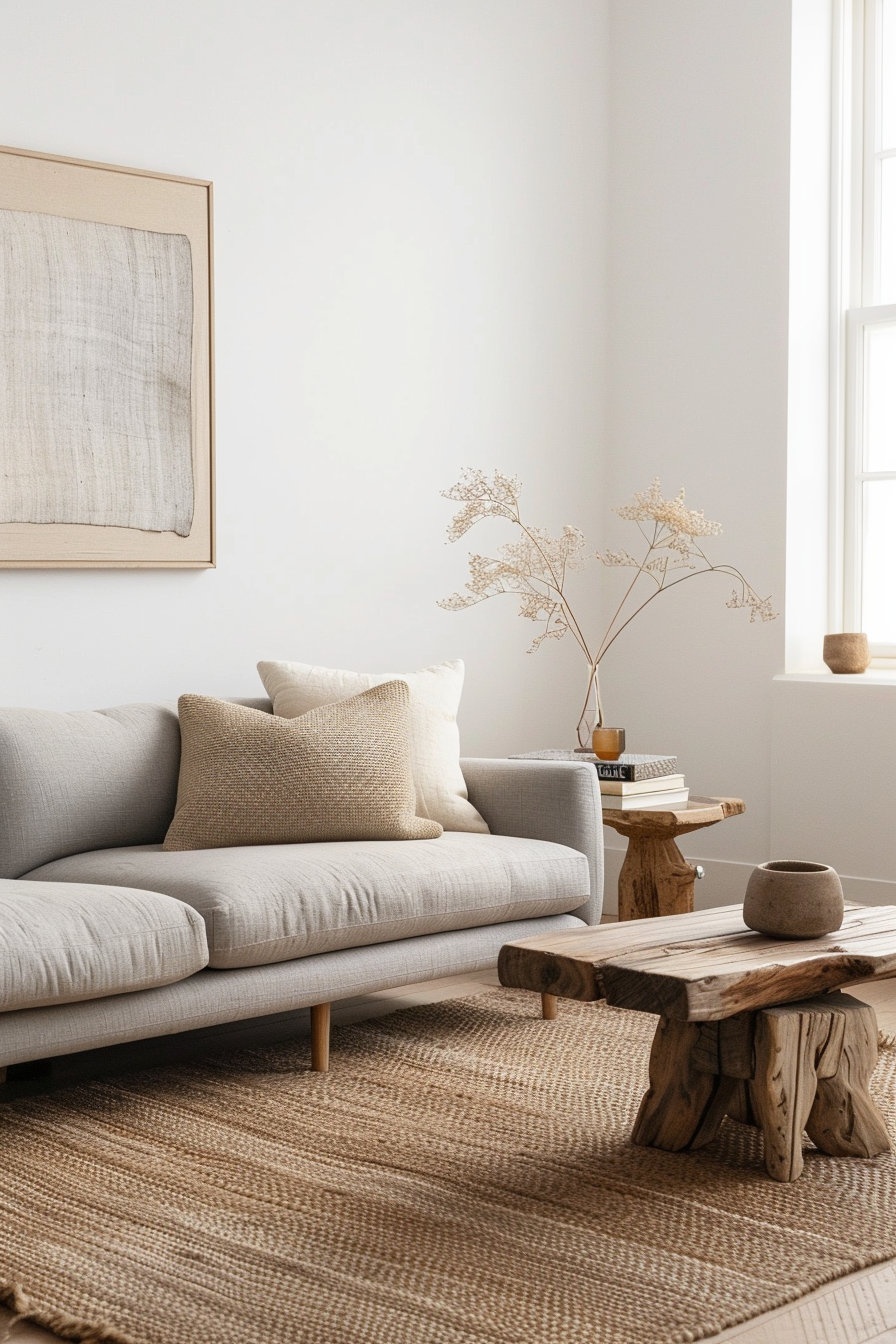
3. Opt for a Gray Couch
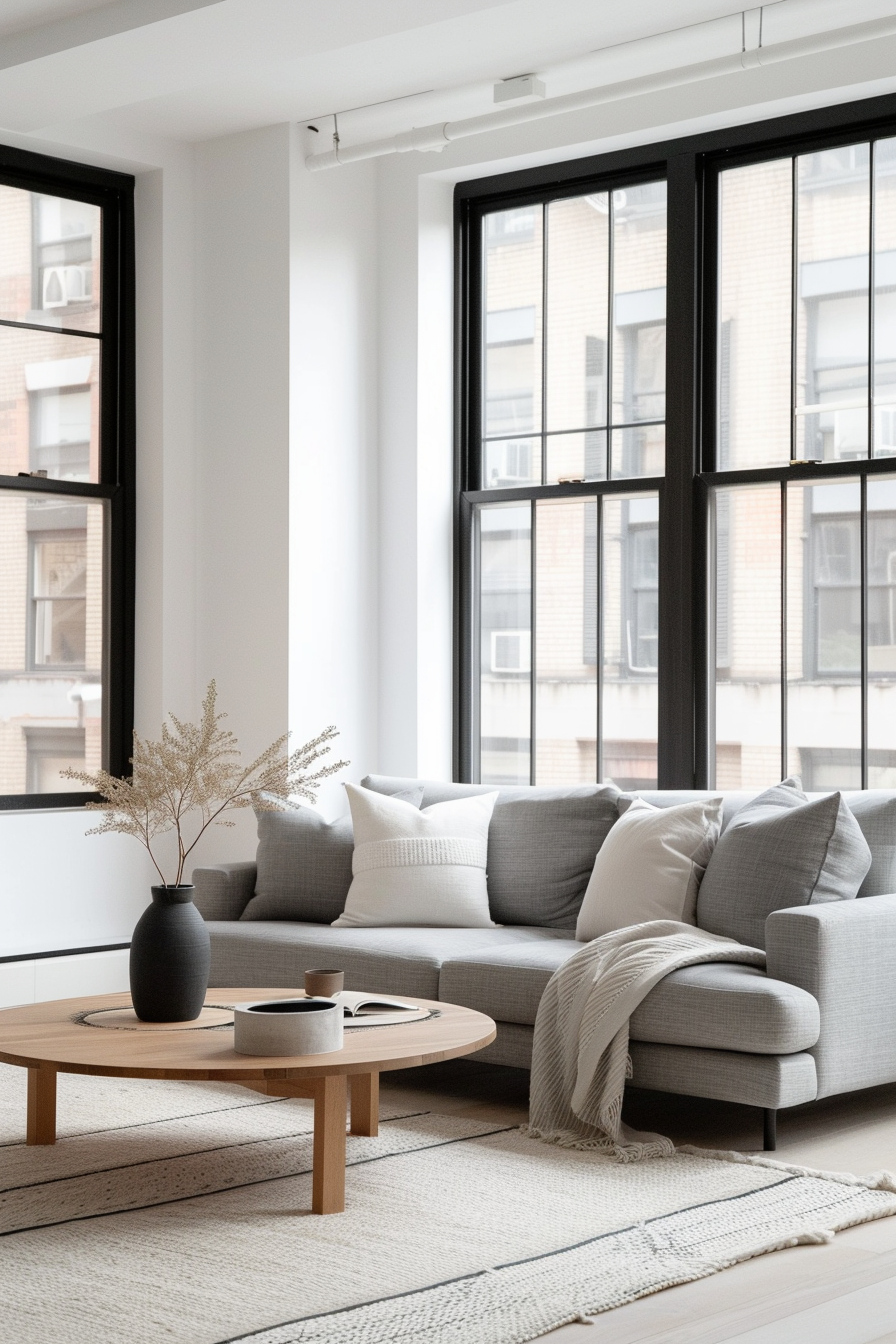
A gray couch serves as a versatile centerpiece in an organic modern living room. Its neutral tone provides a sophisticated base that pairs well with various colors and textures. Whether you choose a light dove gray or a deep charcoal, a gray couch can easily be dressed up or down.
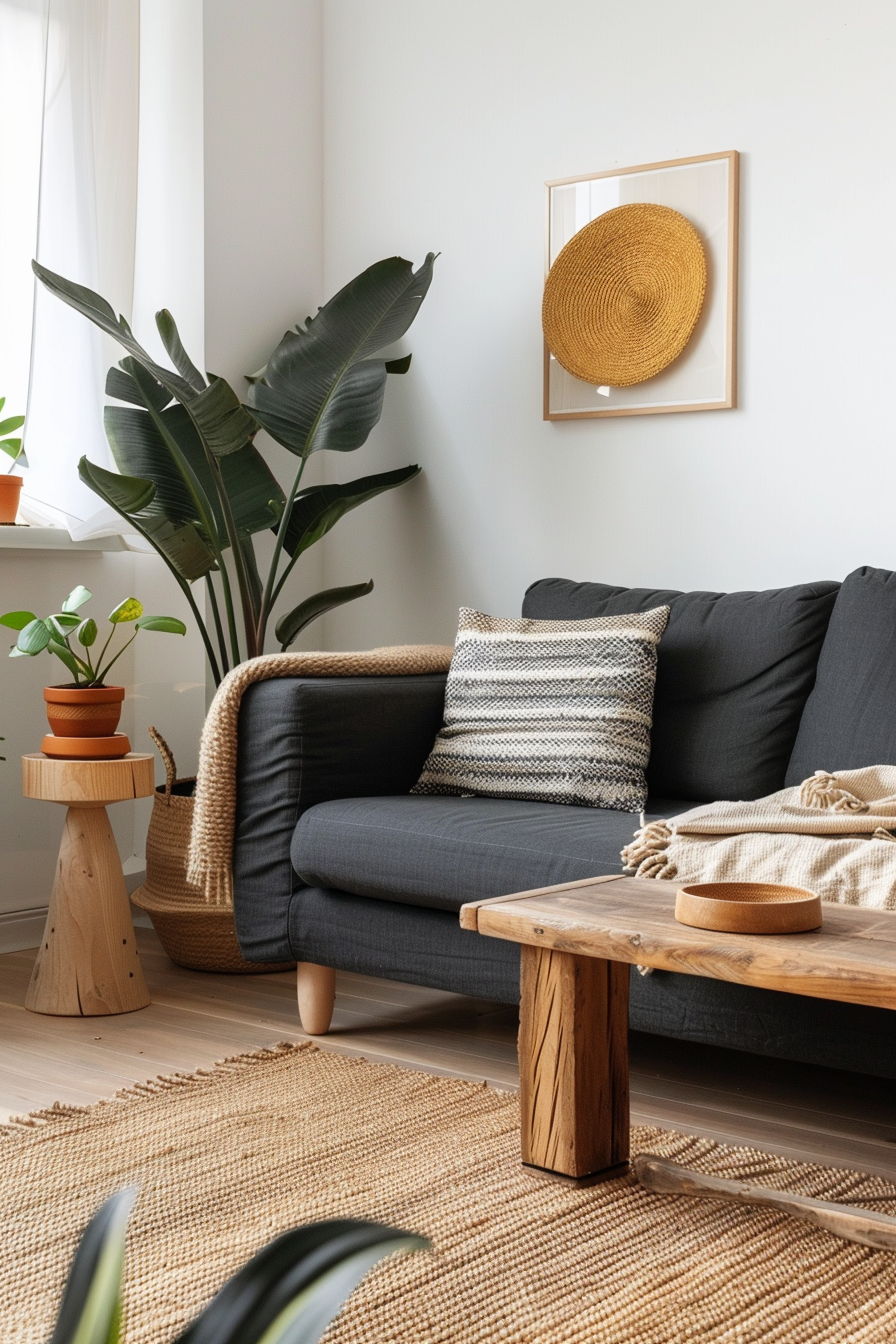
In small spaces, a gray couch can make the room feel more spacious and less cluttered. Its understated color allows other elements, like natural wood furniture or vibrant cushions, to stand out. Consider a sleek, modern design with clean lines to maintain the style’s minimalist aesthetic.
Enhance the couch with organic textiles such as linen or cotton throw blankets and pillows. These add layers of comfort and warmth, making the space inviting and cozy. Choose accessories in earthy tones or subtle patterns to complement the couch and tie the room together.
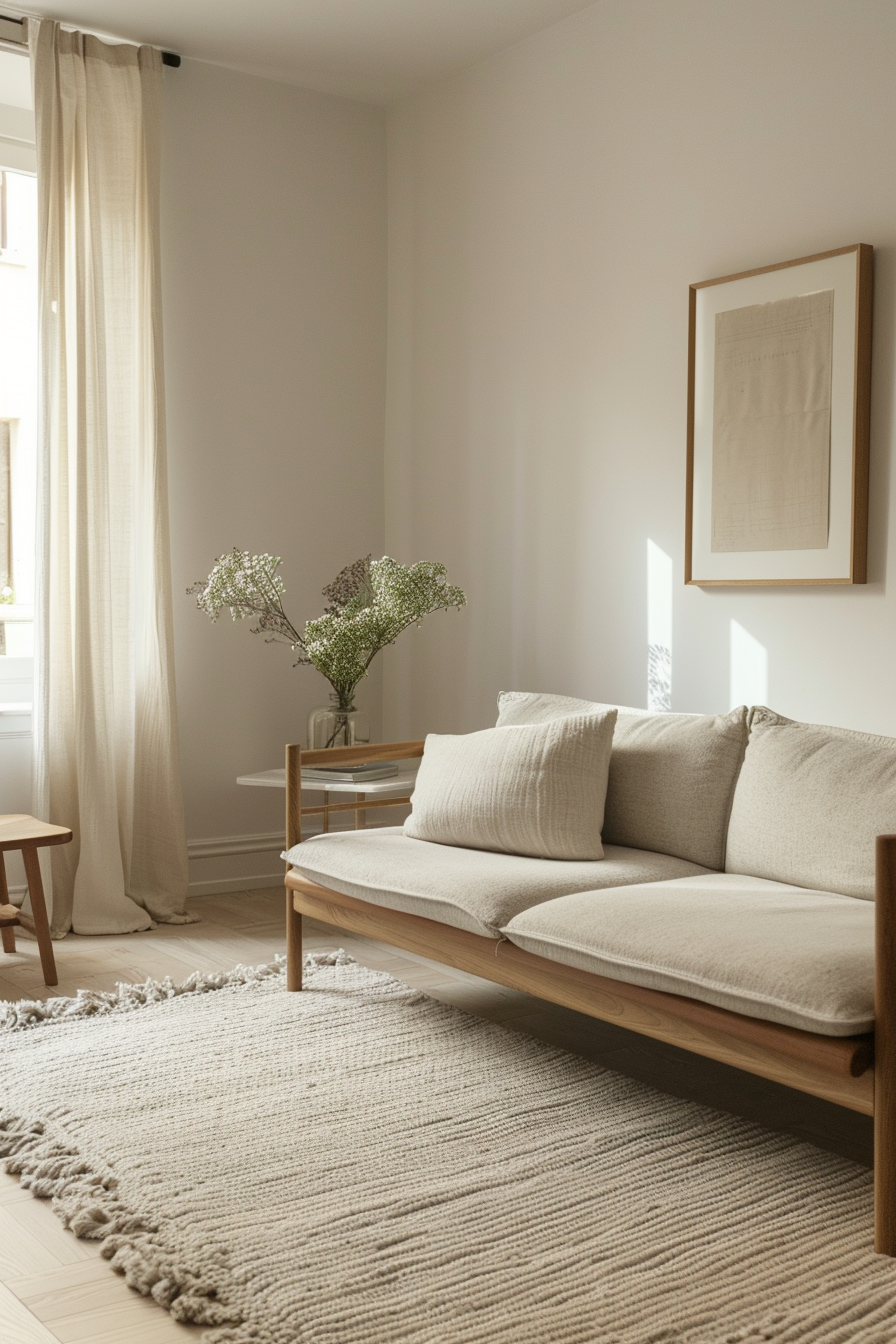
4. Maximize Small Spaces
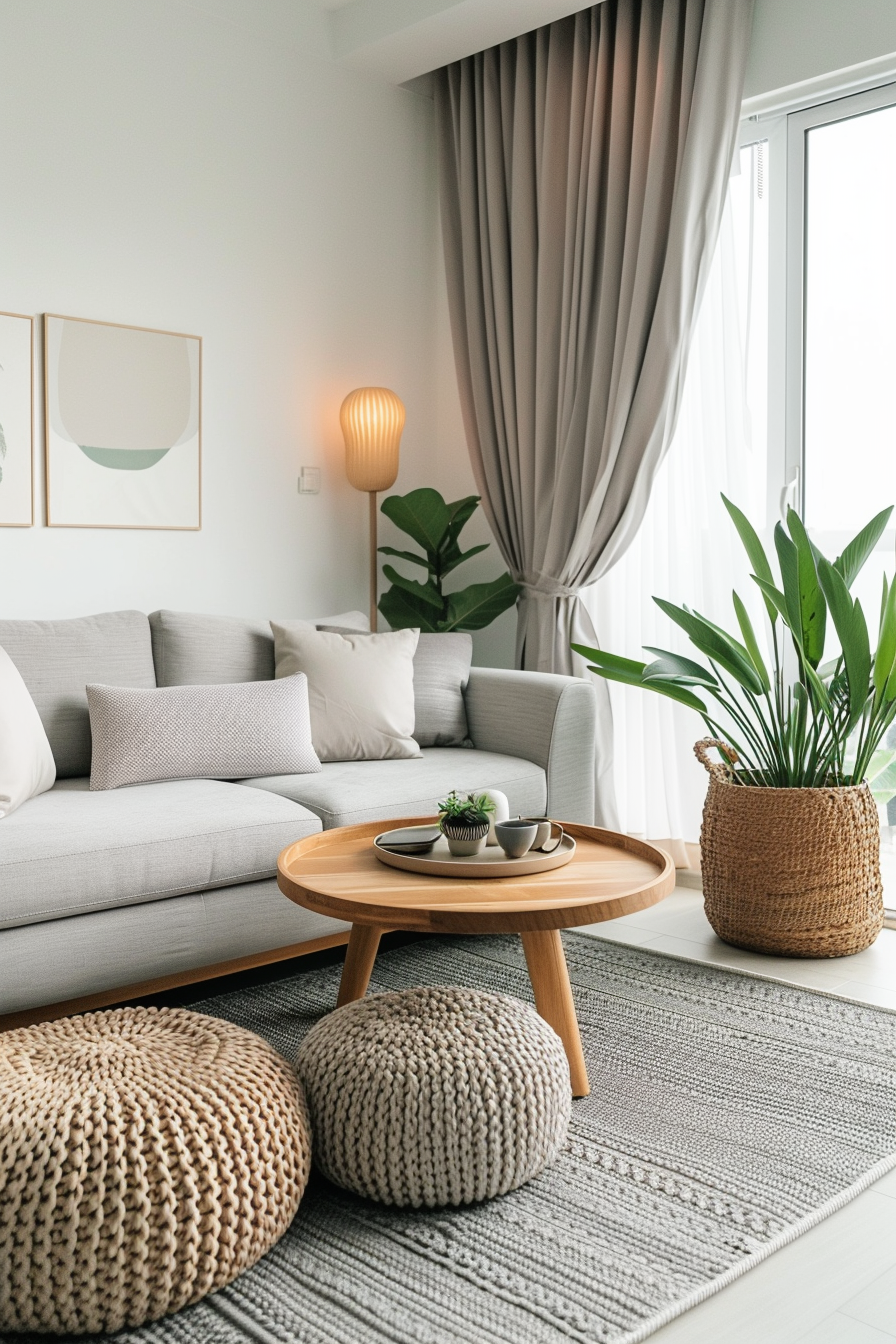
Designing an organic modern living room in a small space requires careful planning to ensure functionality without sacrificing style. Focus on multi-functional furniture that offers storage or serves multiple purposes. For example, a coffee table with built-in storage or an ottoman that doubles as a seat and a storage unit can be invaluable.
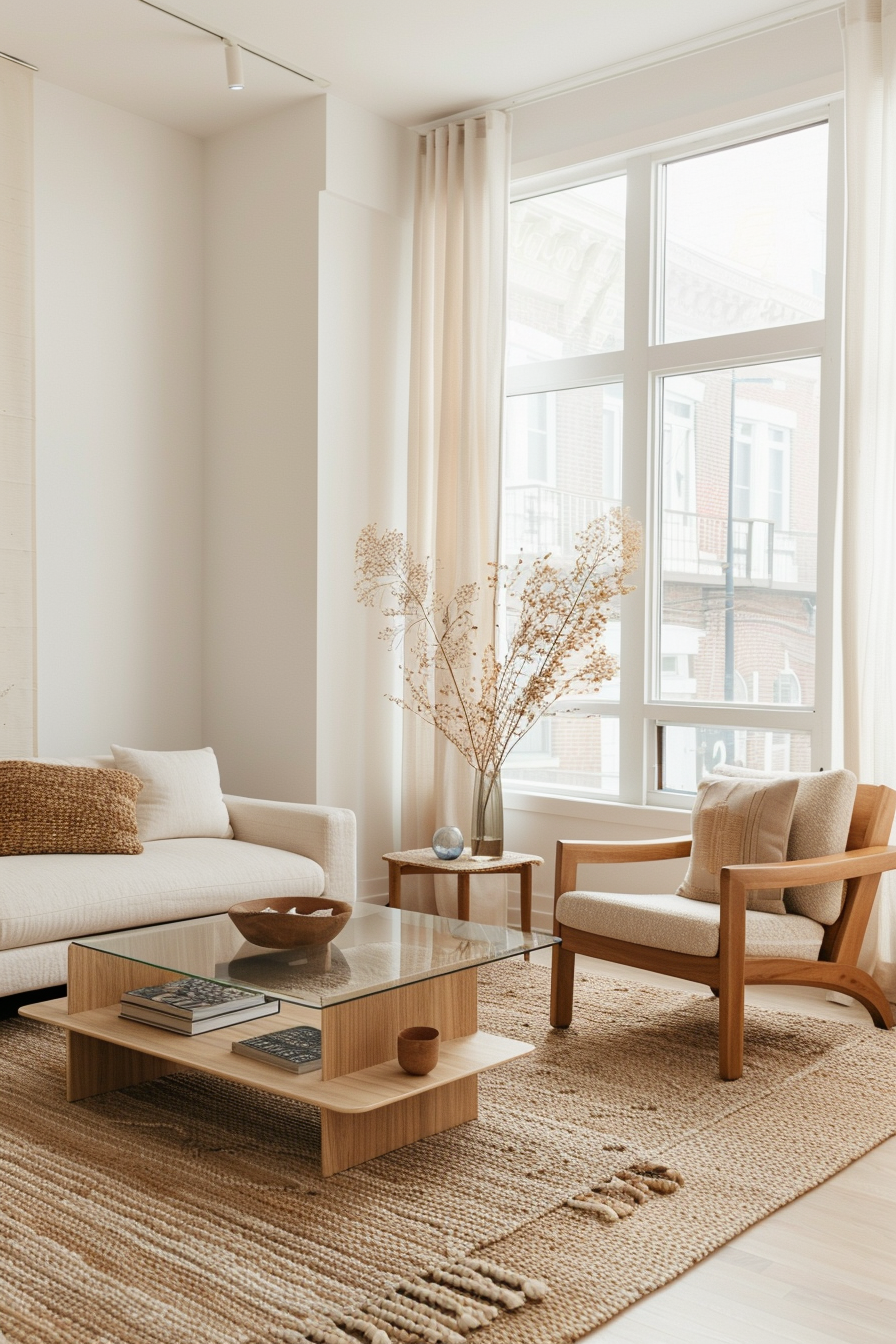
Keep the space open and uncluttered by choosing streamlined furniture with clean lines. Avoid heavy, bulky pieces that can overwhelm a small room. Instead, opt for slender furniture legs and transparent elements like glass tables to maintain a sense of openness.
Use light colors and reflective surfaces to enhance the room’s brightness and make it appear larger. Mirrors, light wood finishes, and strategically placed lighting can help bounce light around the room, creating a more spacious feel. Incorporating these elements will ensure your small living space remains airy and inviting.
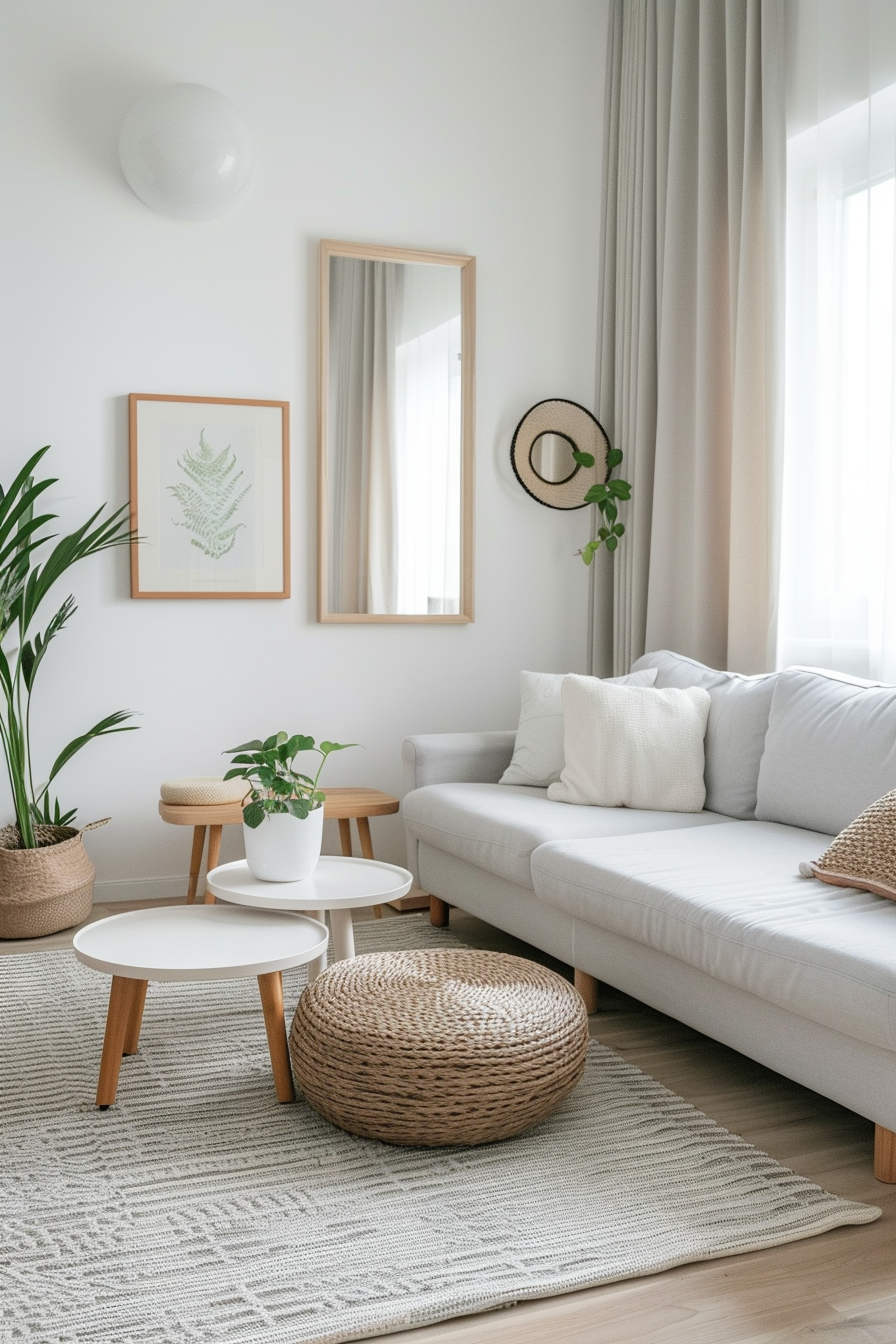
5. Focus on Lighting
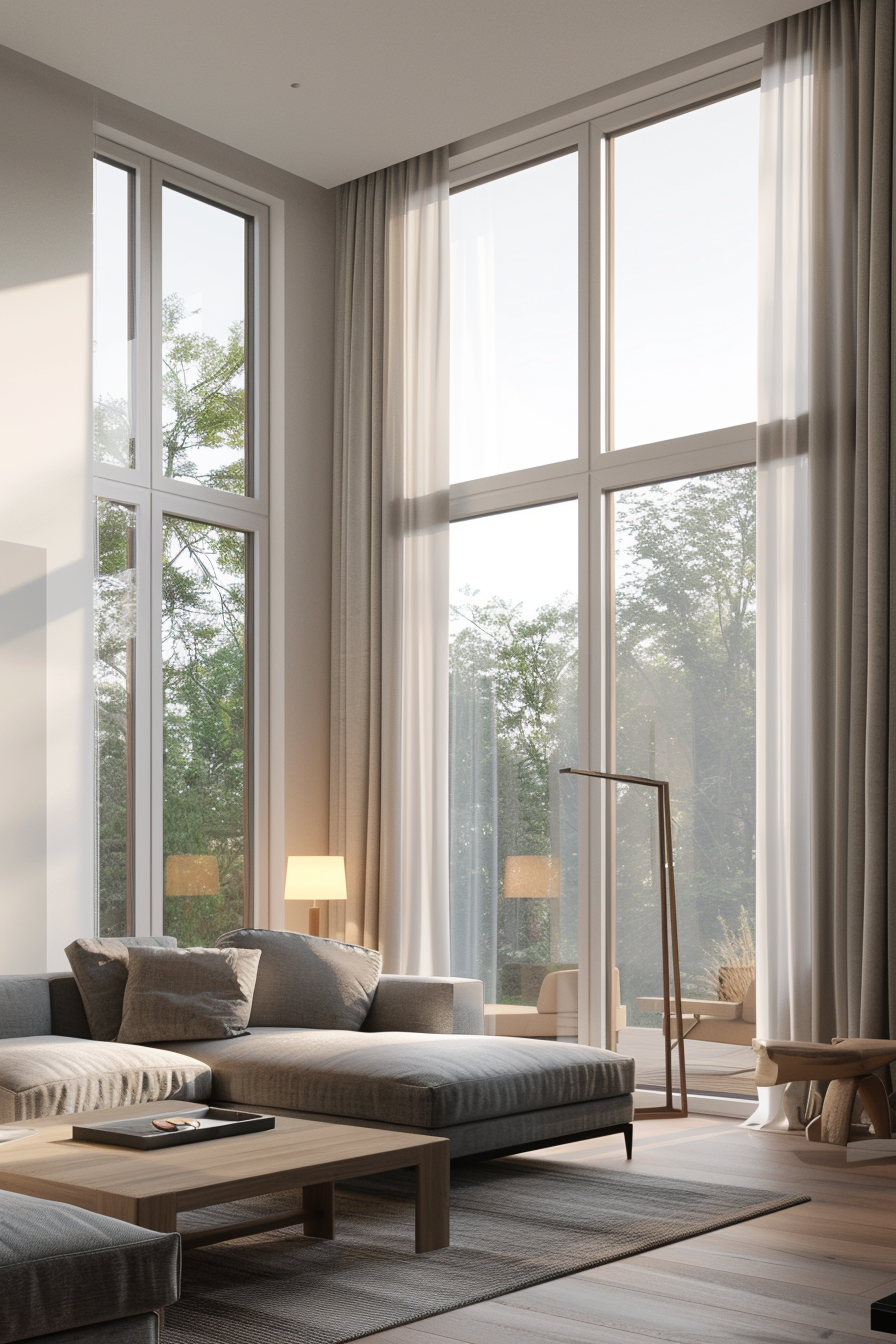
Lighting plays a crucial role in creating the warm, inviting atmosphere of an organic modern living room. Aim for a mix of natural and artificial lighting to balance the space. Large windows with sheer curtains can maximize natural light, while strategically placed lamps and fixtures can add layers of illumination.
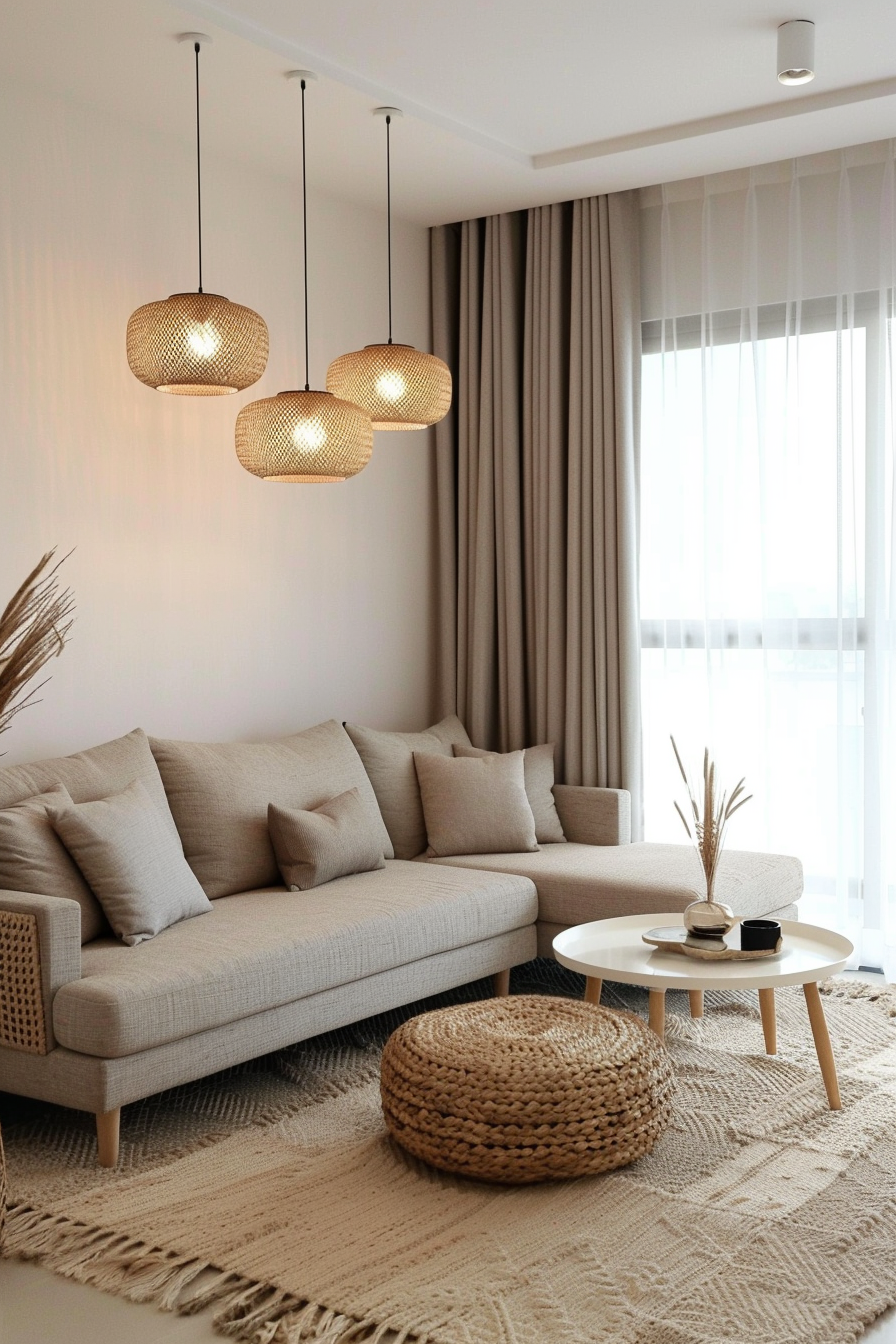
Choose lighting fixtures that align with the organic modern aesthetic. Pendant lights with natural materials like wood or metal, simple floor lamps with clean lines, and table lamps with neutral shades can all enhance the style. The goal is to provide ample light while maintaining a minimalist and cohesive look.
Consider adding dimmable lights or adjustable lamps to control the mood and ambiance. Soft, warm lighting can make the room feel cozy and intimate in the evenings, while brighter lights can energize the space during the day. This flexibility allows you to adapt the lighting to different activities and times of day.
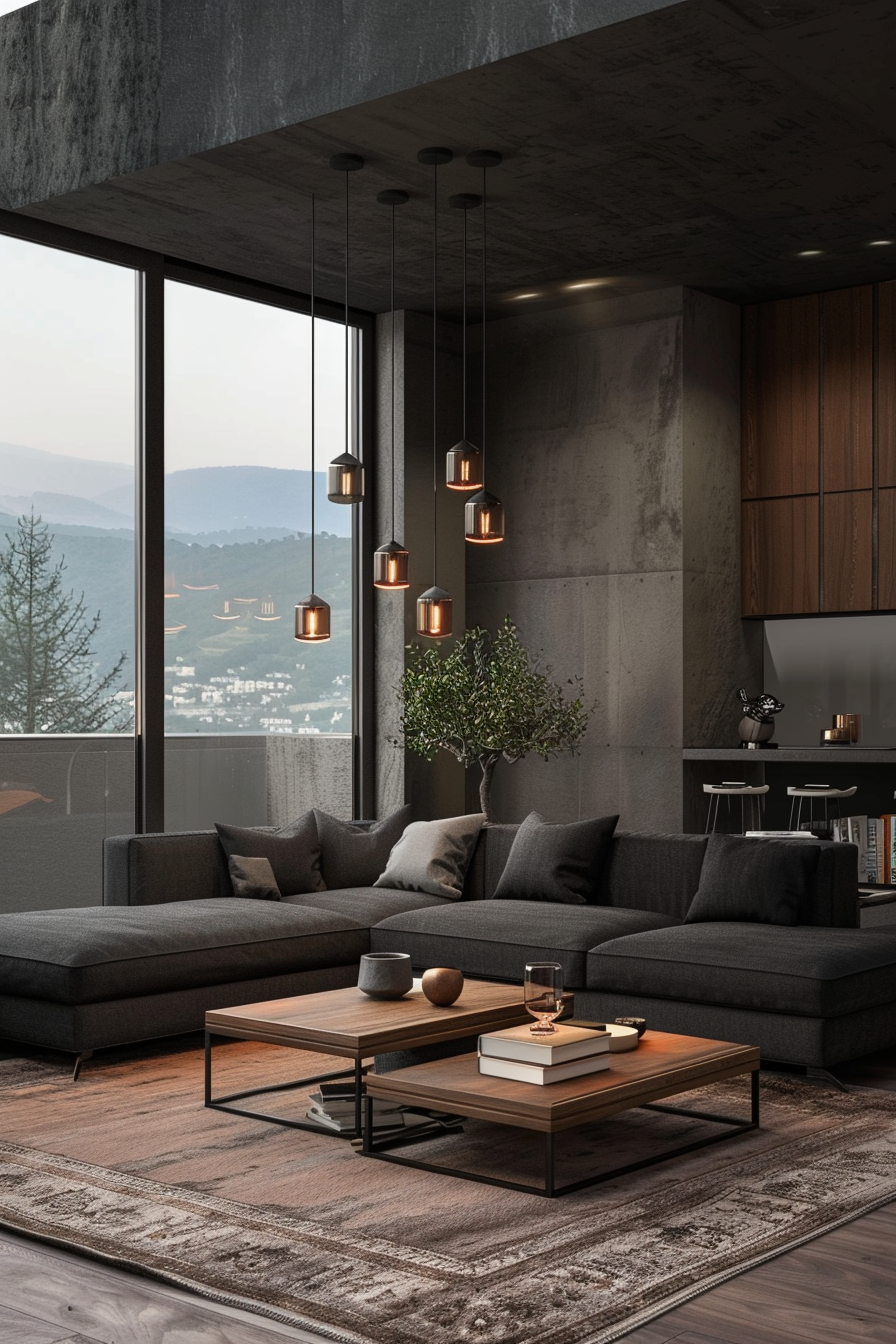
6. Incorporate Black and White Wood Accents
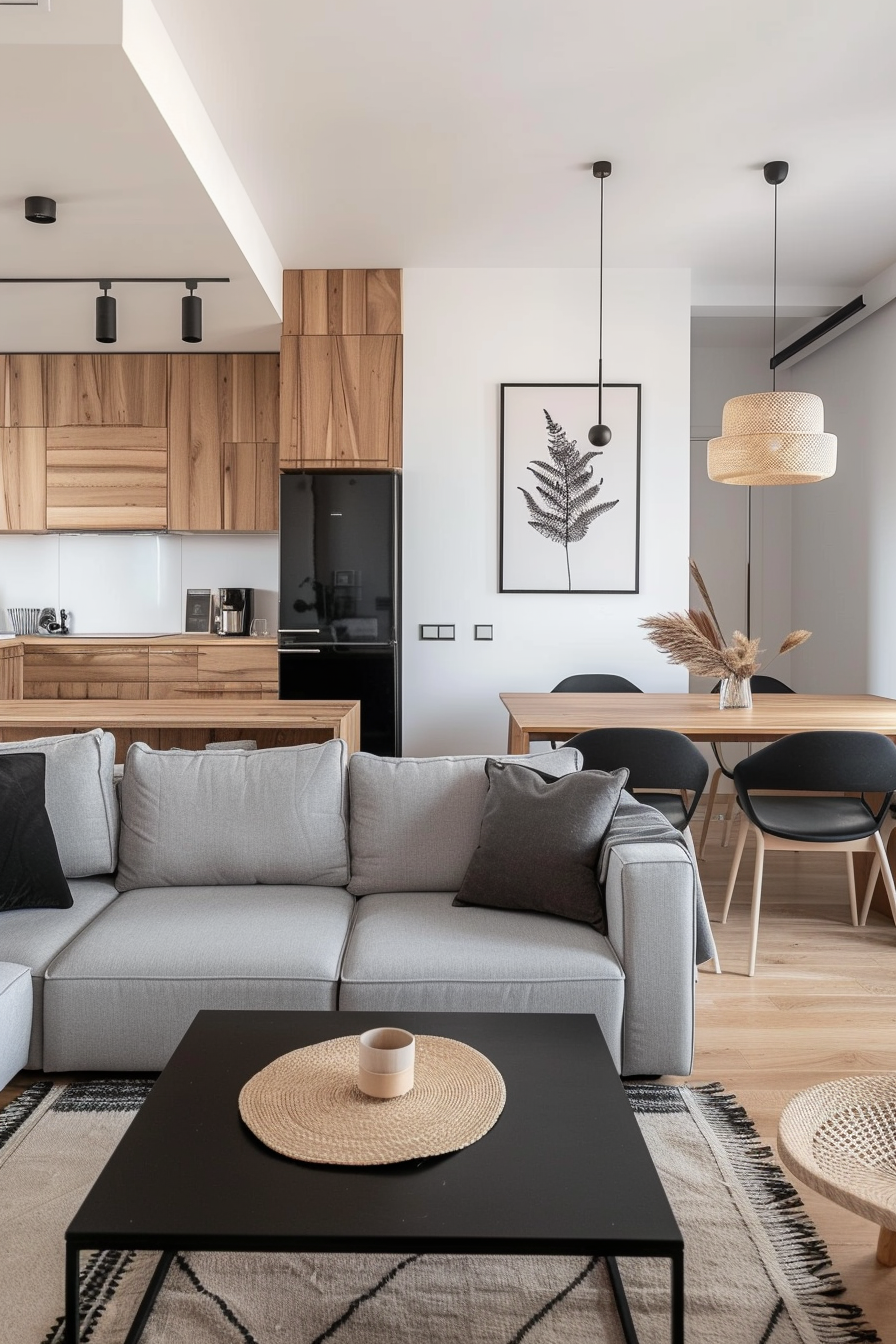
Integrating black and white wood elements can add a striking contrast to your organic modern living room while maintaining its clean and natural aesthetic. Black wood accents, such as frames or furniture legs, provide a bold touch that grounds the space and adds sophistication. In contrast, white wood elements keep the room light and airy.
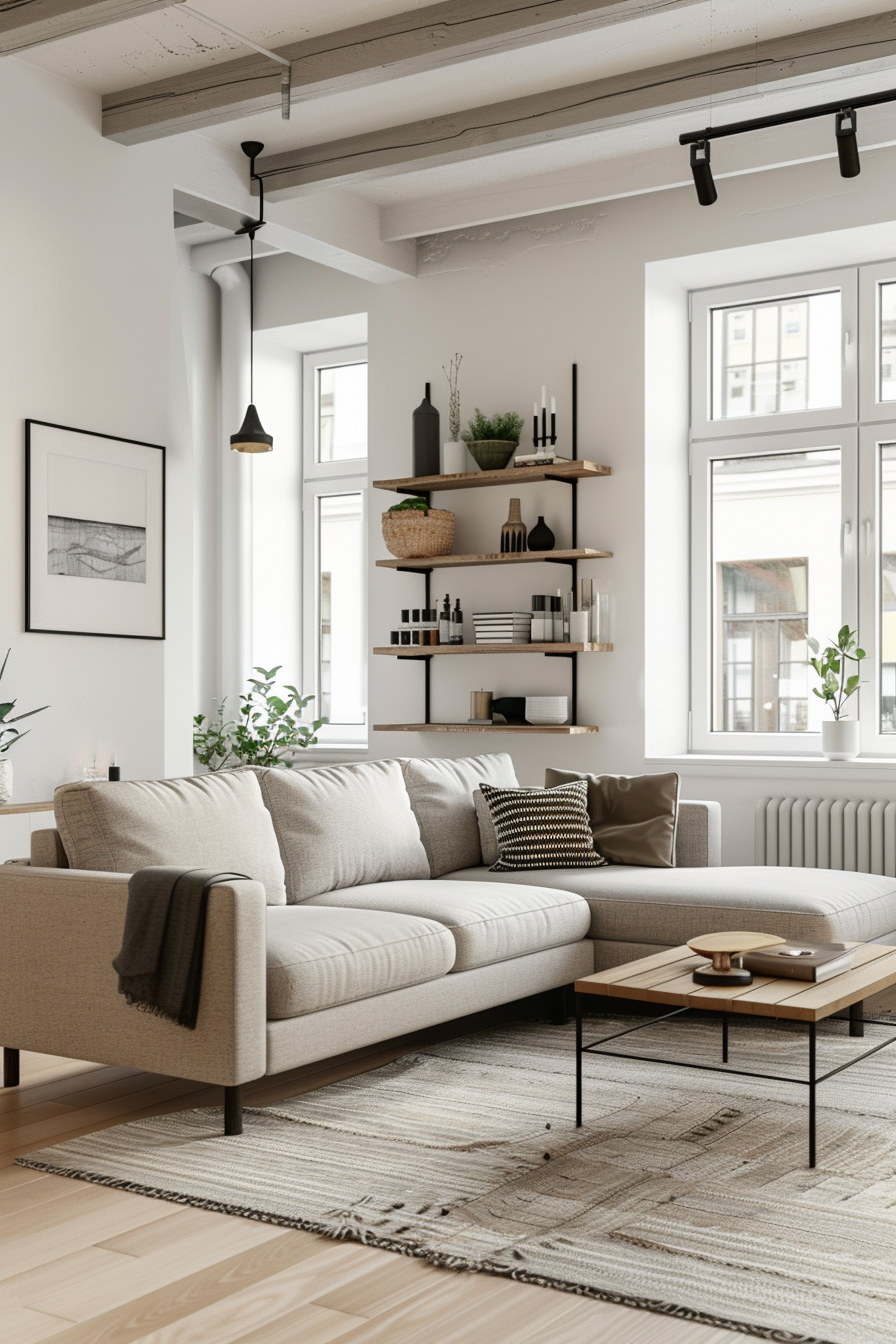
Consider using black wood for focal pieces, such as a coffee table or a media console, to create a strong visual anchor. Balance these with white wood accessories or smaller furniture pieces to prevent the room from feeling too dark. This combination can create a dynamic yet harmonious look.
Incorporate these wood accents through shelving, frames, or even in the details of your furniture. Black and white wood not only adds visual interest but also ties together various elements of the room, creating a cohesive and well-designed space.
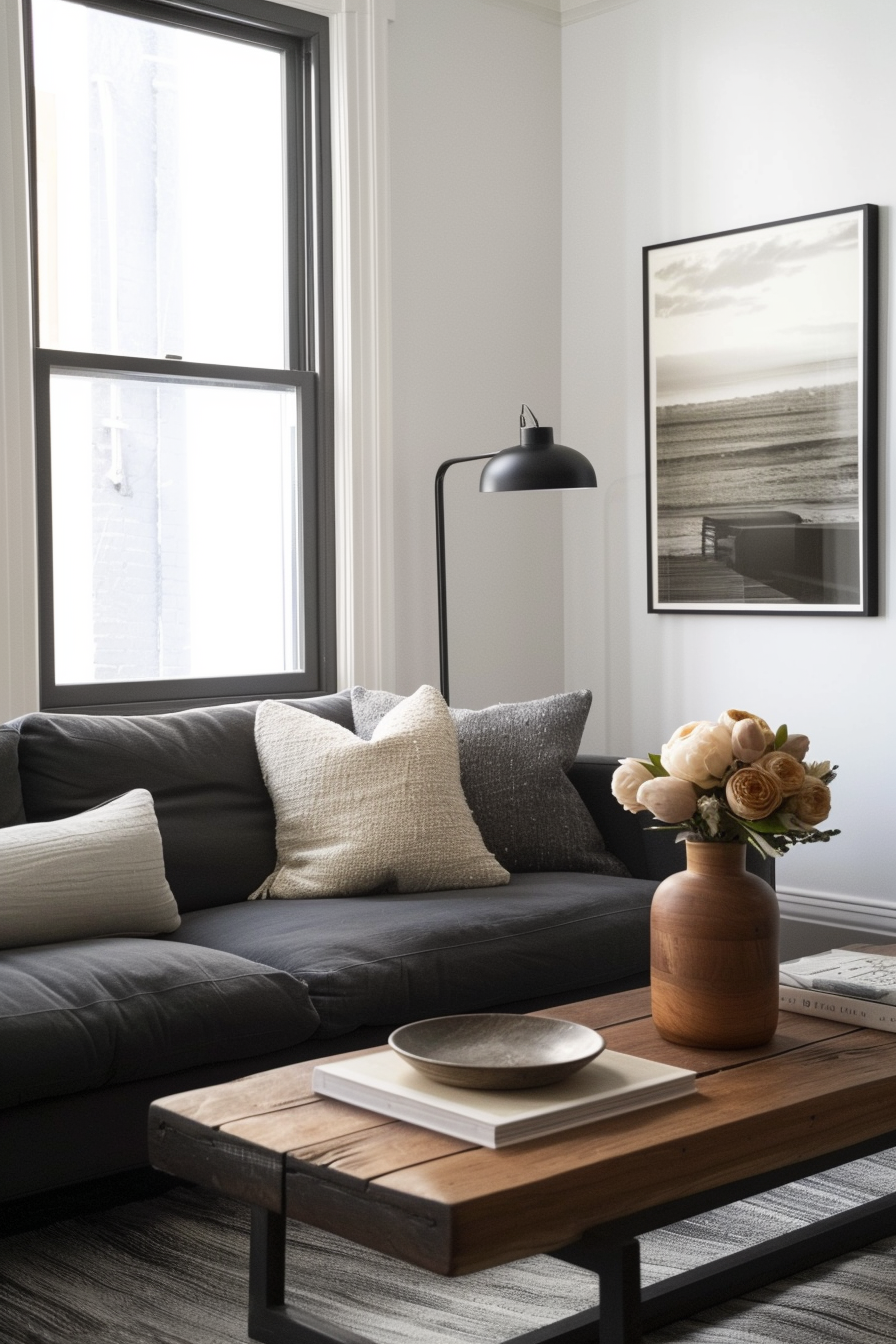
7. Embrace Organic Textiles
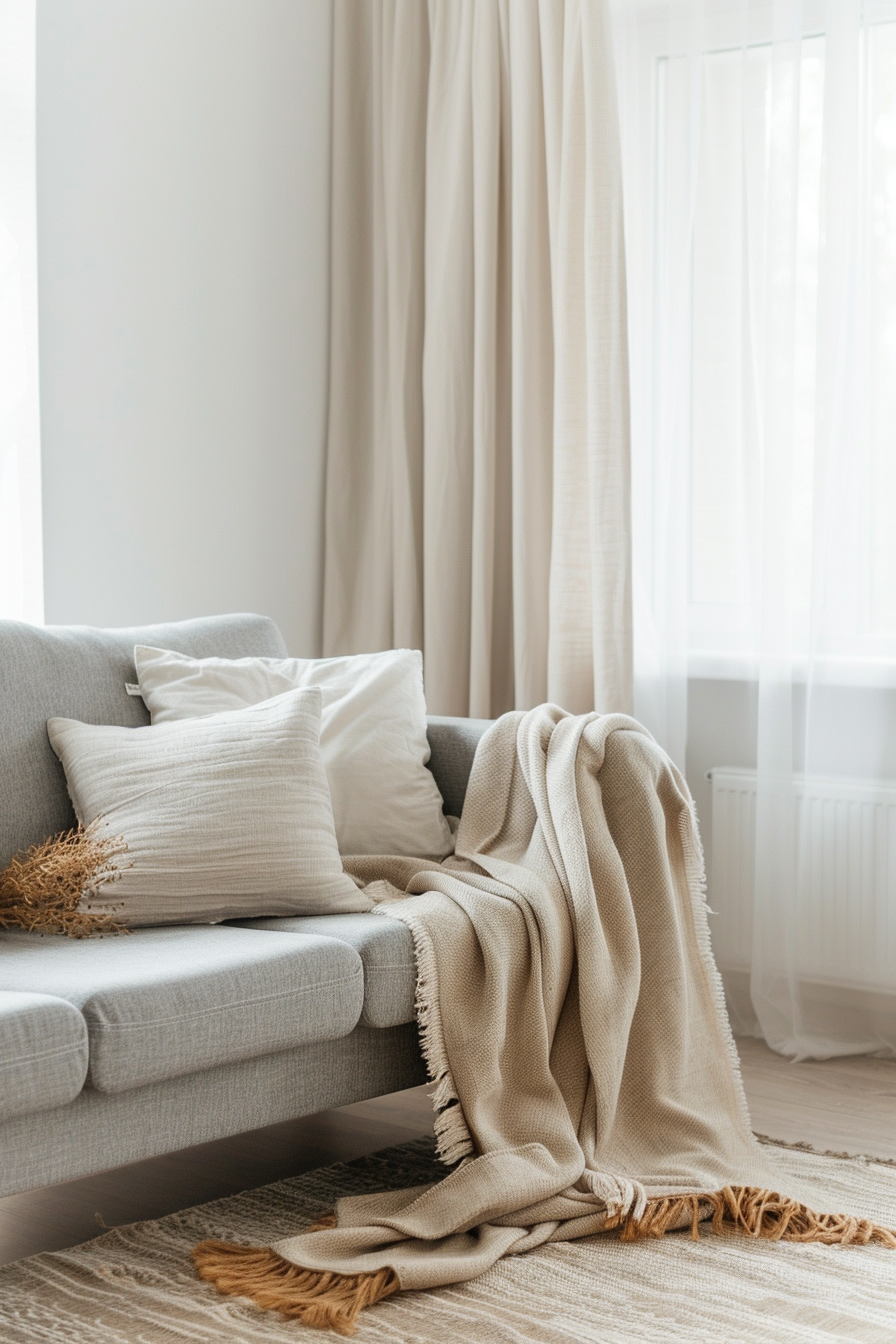
Organic textiles like linen, cotton, and wool are perfect for an organic modern living room. These materials not only add warmth and texture but also promote a sense of comfort and well-being. They can be used in various forms, from upholstery and cushions to rugs and curtains.
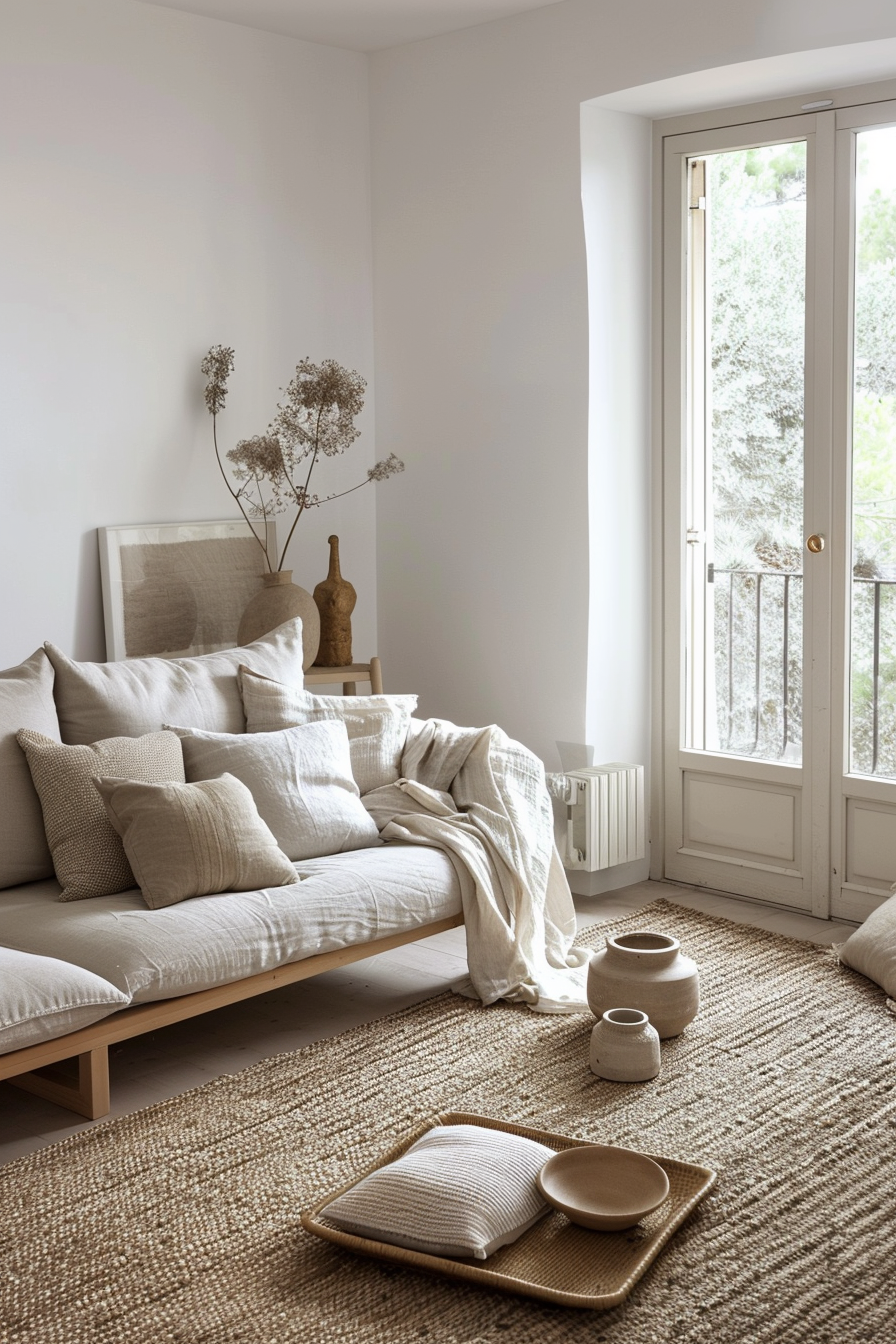
Incorporate linen or cotton throw pillows and blankets to add softness and a touch of luxury to your seating area. These textiles are breathable and easy to maintain, making them ideal for everyday use. Choose natural, muted colors to complement the overall palette of the room.
For a more substantial texture, consider adding a wool or jute rug. These materials are durable and add a tactile element underfoot. Curtains made from organic textiles can also enhance the room’s natural aesthetic while providing privacy and softening the light.
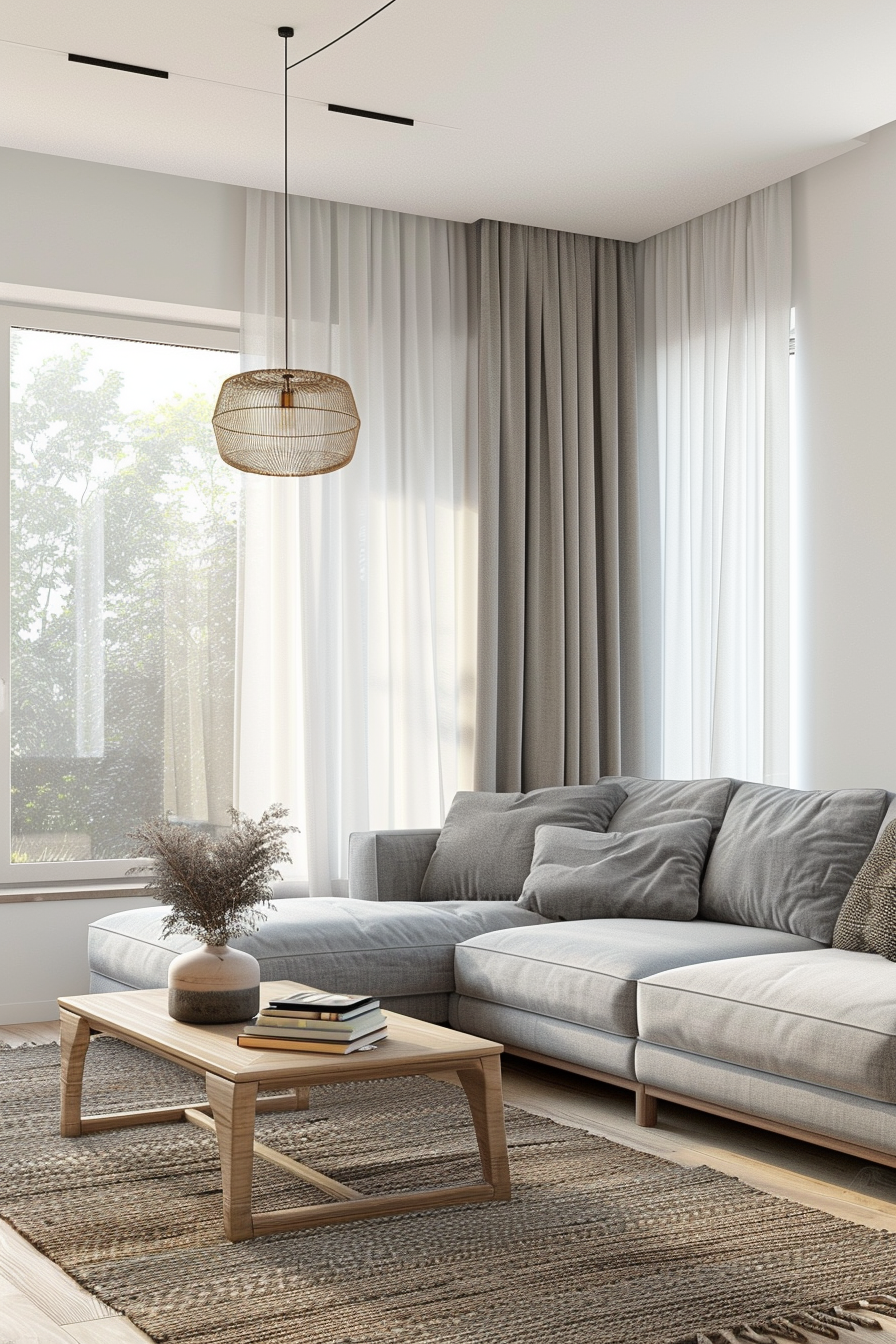
8. Design a Functional TV Wall
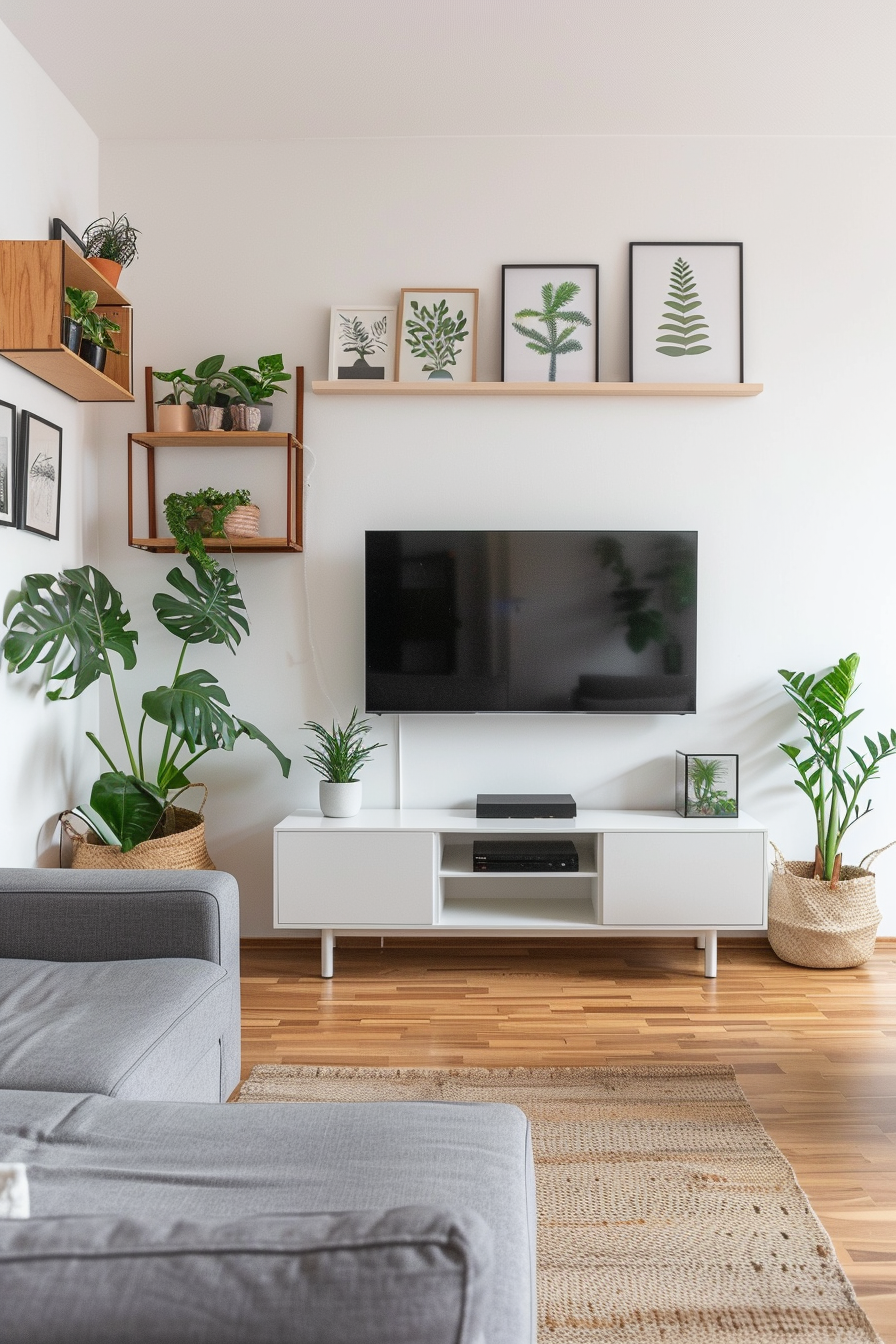
In an organic modern living room, the TV wall should blend seamlessly into the design rather than dominate it. Consider using built-in shelving or a media console that matches the room’s aesthetic. This can provide both storage and a place to display decorative items, helping to integrate the TV into the overall look.
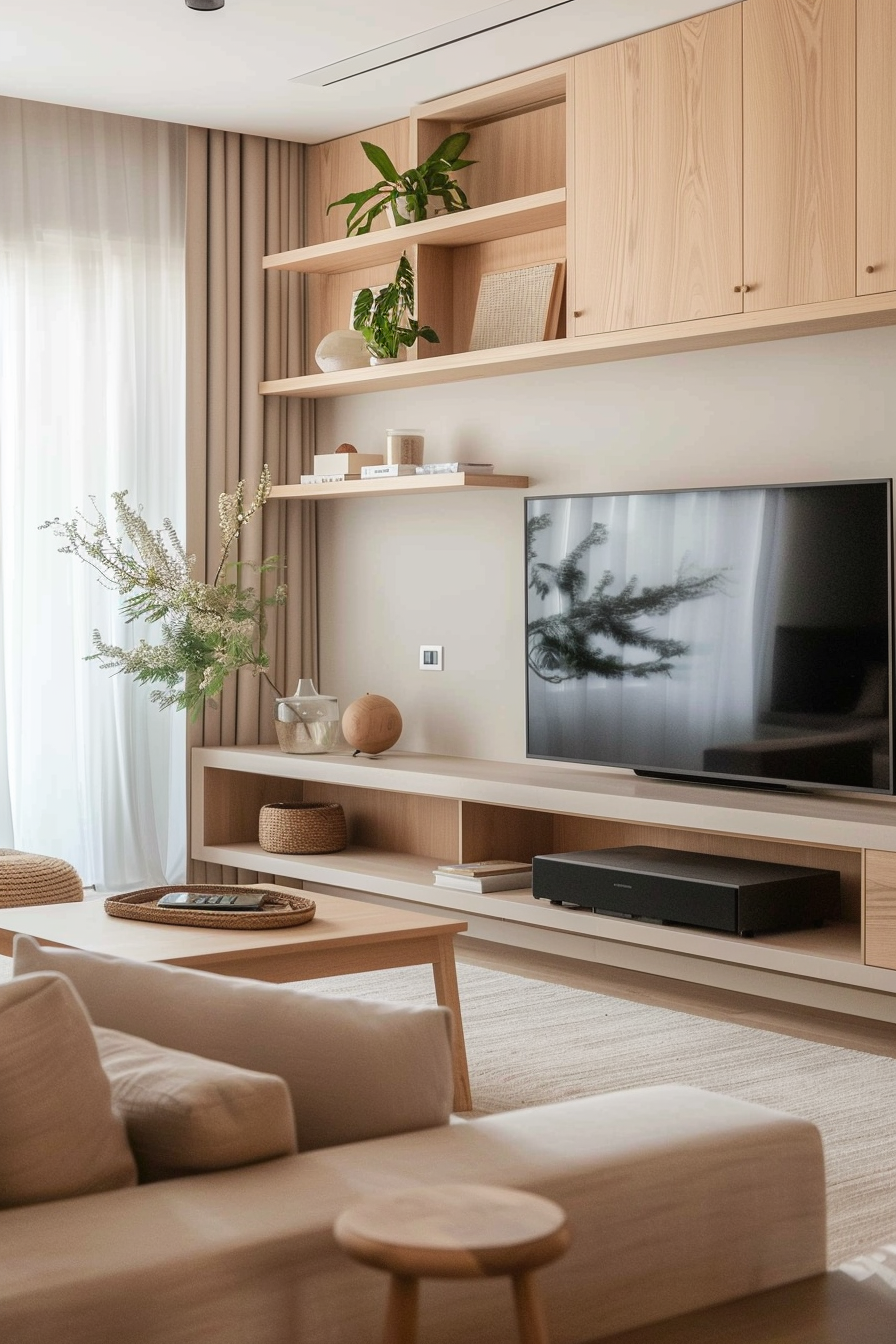
Use neutral colors and natural materials for the TV unit to ensure it aligns with the organic modern style. For example, a white or light wood media console can complement a gray couch and neutral walls. Incorporate closed storage options to keep clutter out of sight and maintain a clean, streamlined appearance.
Decorate around the TV with framed art, plants, or other decor pieces that reflect your personal style. This can help draw the eye away from the screen when it’s not in use and make the TV wall a more cohesive part of the room’s design.
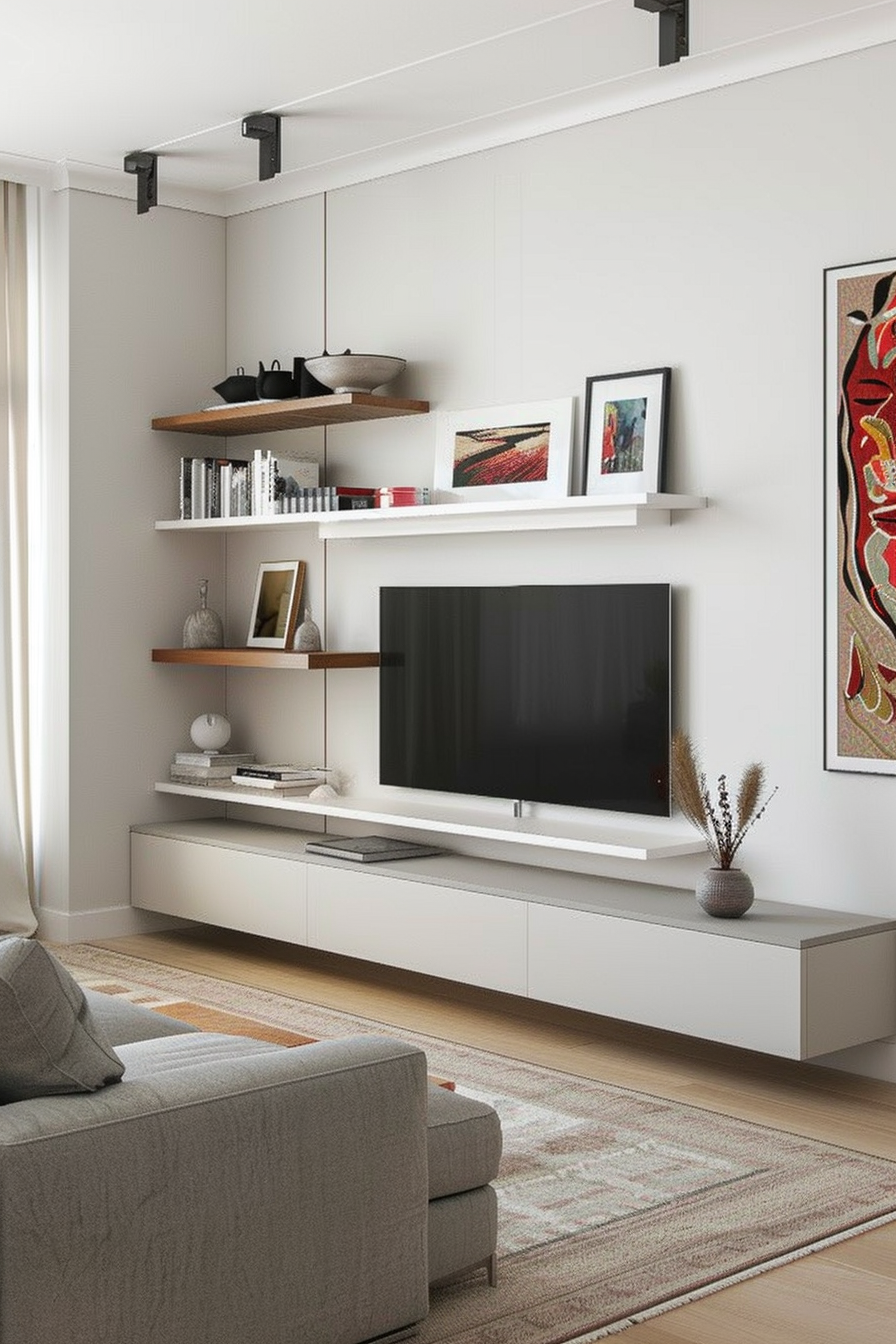
9. Draw Inspiration from Nature
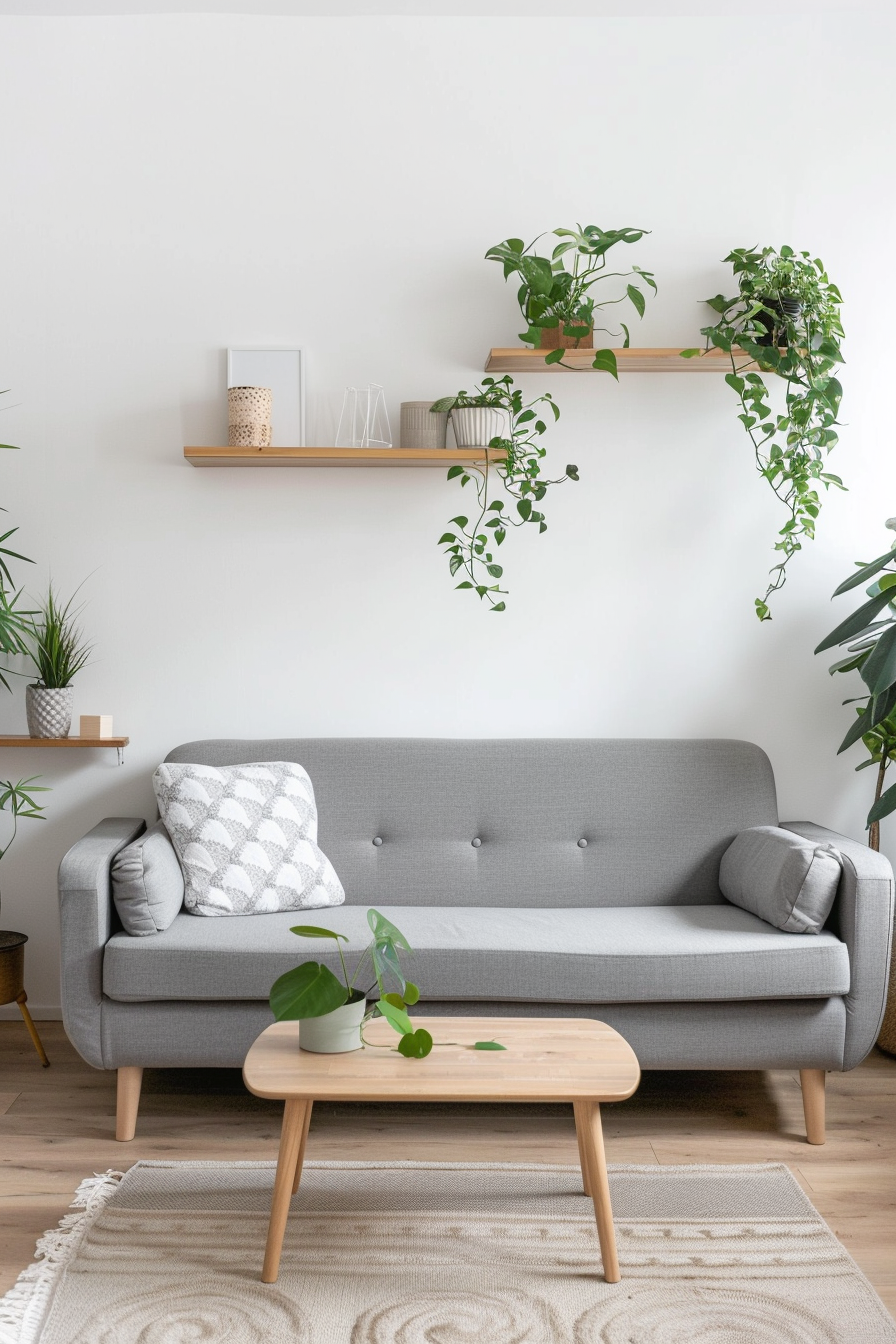
Nature is a key inspiration for the organic modern style. Bringing elements from the outdoors into your living room can create a calming and refreshing environment. Consider incorporating natural materials, colors, and forms that reflect the beauty of the natural world.
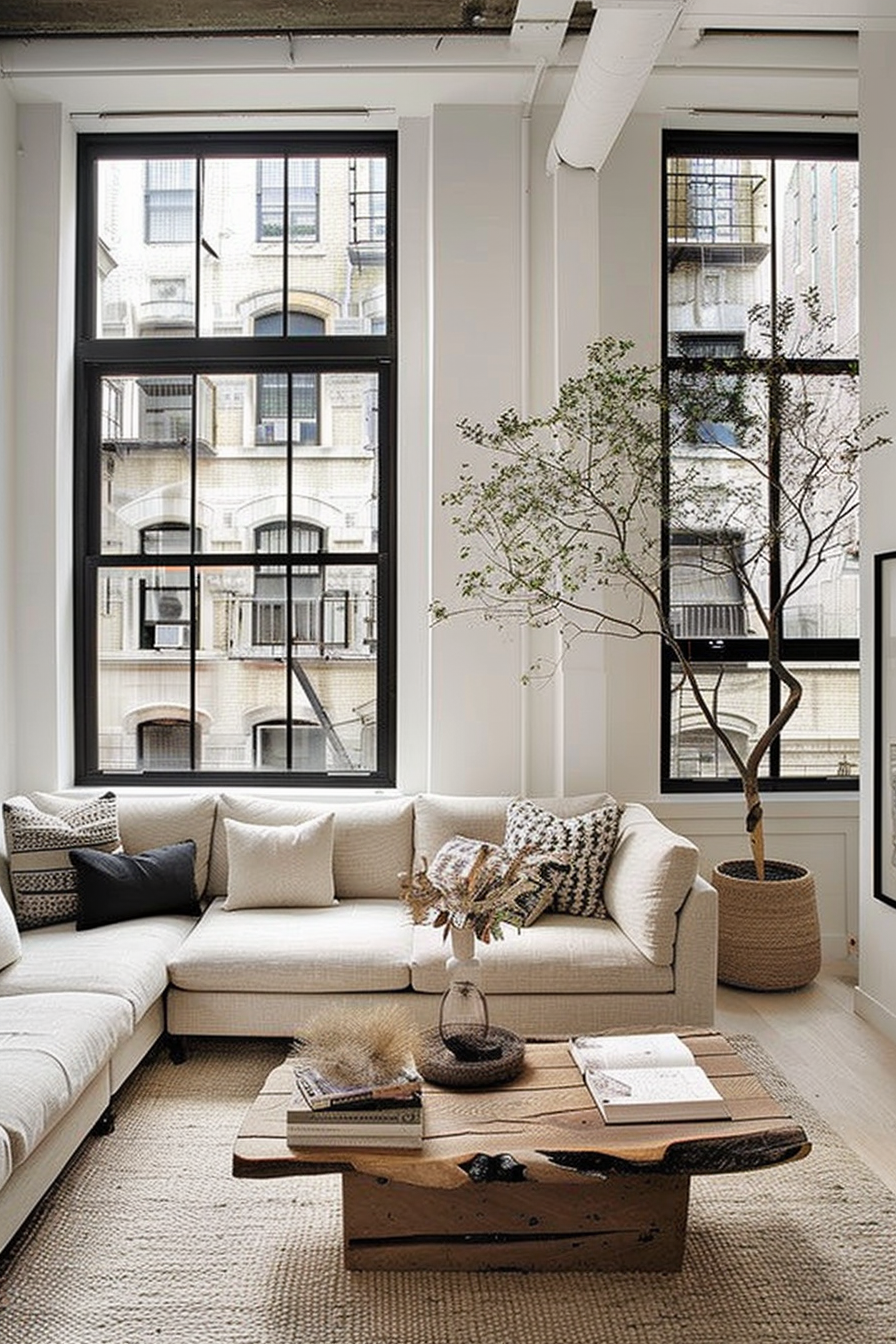
Start with greenery. Houseplants are a fantastic way to add life and color to your living room. Choose plants that thrive in indoor environments and place them in stylish pots that complement your decor. Plants not only enhance the aesthetic but also improve air quality and promote a sense of well-being.
Incorporate natural textures and patterns through decor and furniture. Wood, stone, and woven textiles can all evoke the organic feel you’re aiming for. Use these materials in their natural state to highlight their inherent beauty and create a connection with nature.
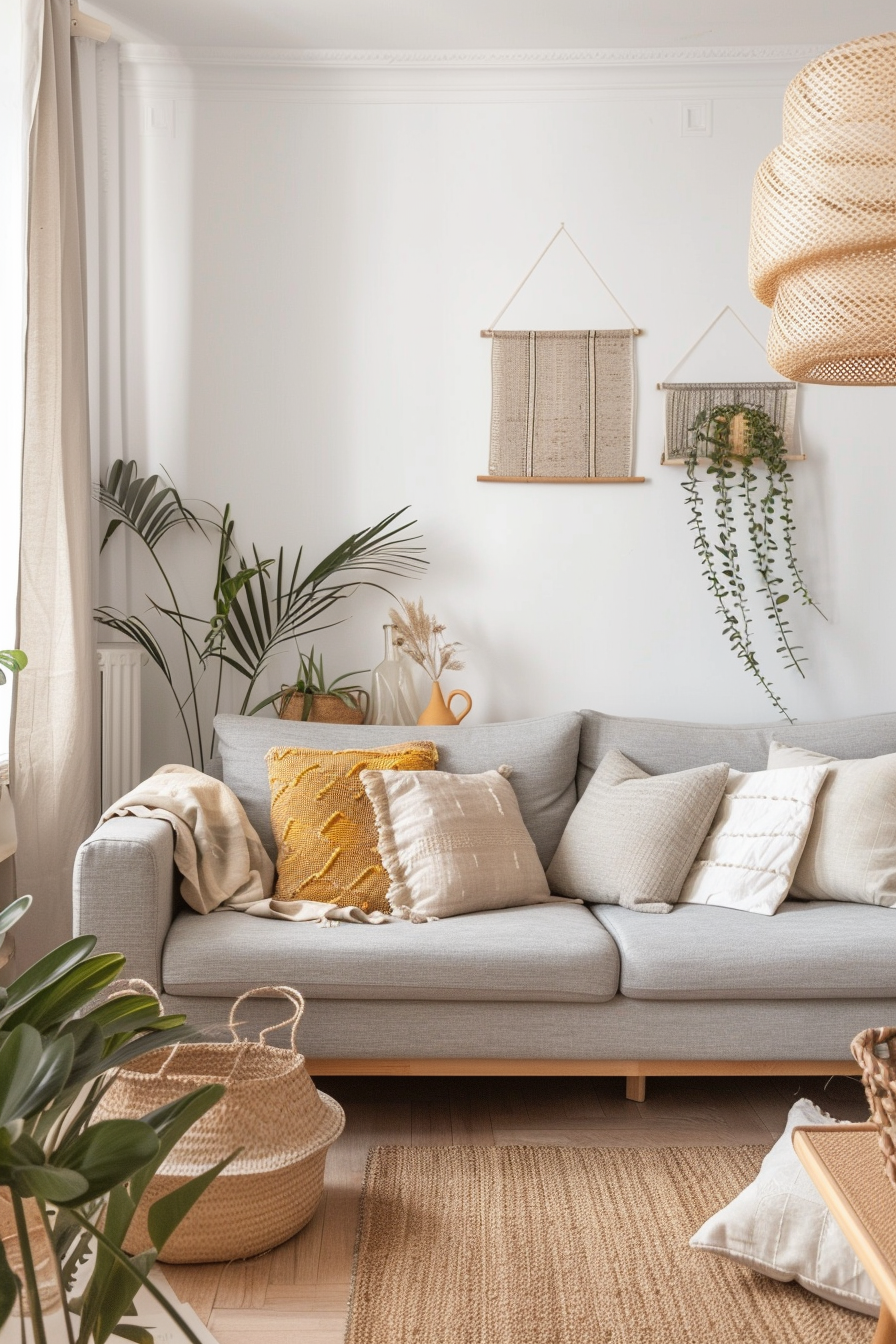
10. Add Vintage Touches
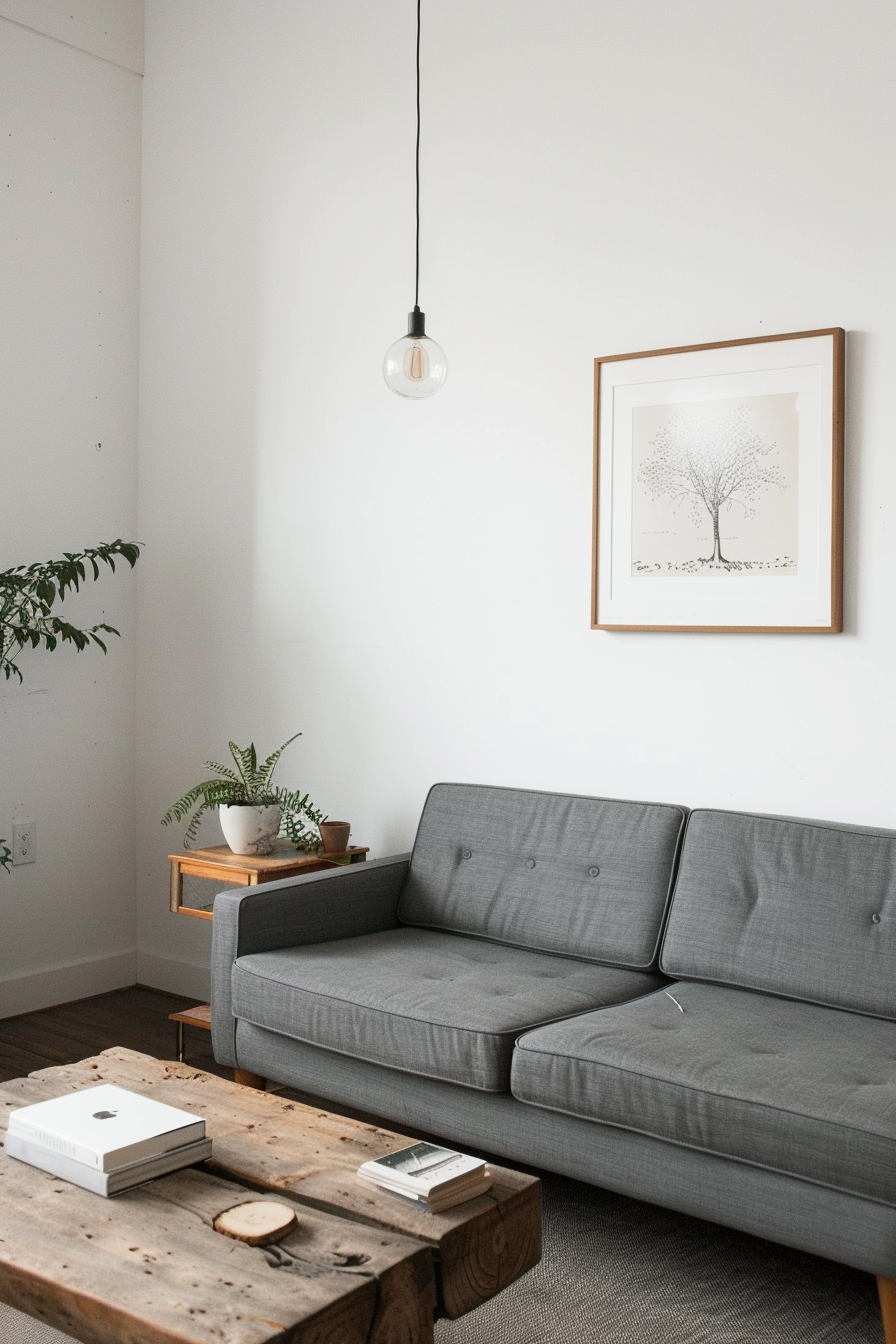
Incorporating vintage pieces into your organic modern living room can add character and a sense of history. Look for furniture or decor items with clean lines and timeless appeal that can seamlessly blend into the modern aspects of the room. These pieces can provide a unique contrast and make the space feel more personal and eclectic.
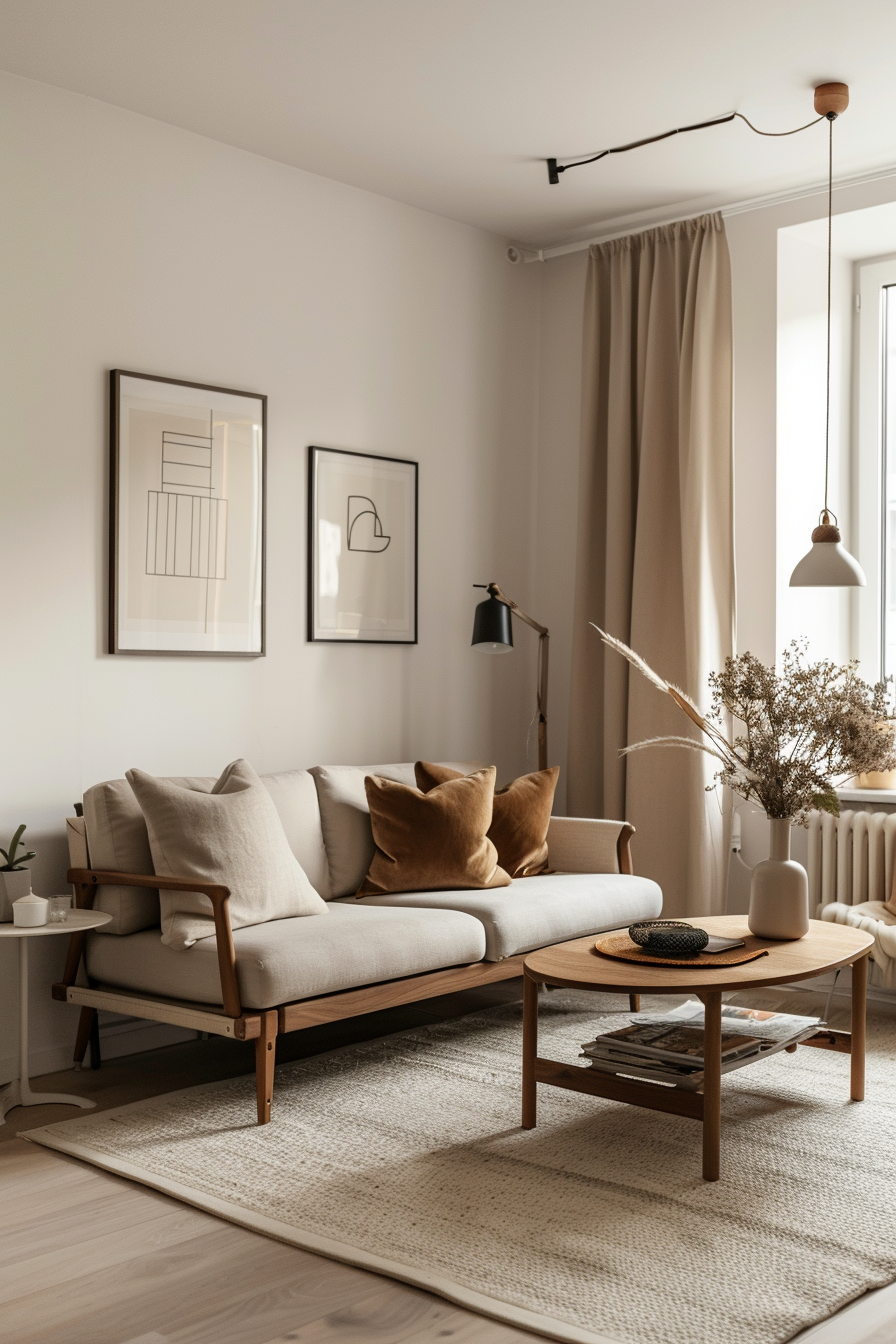
Consider a vintage coffee table or a set of side tables with a patina that adds warmth and depth. Vintage lighting fixtures, like a mid-century modern lamp or an antique chandelier, can also add charm and sophistication. These items often have a quality and craftsmanship that stands the test of time.
Mix vintage and modern elements thoughtfully to avoid a disjointed look. Use vintage pieces as focal points or accents, and pair them with contemporary furniture and decor. This balanced approach will create a cohesive and harmonious space that feels both fresh and nostalgic.
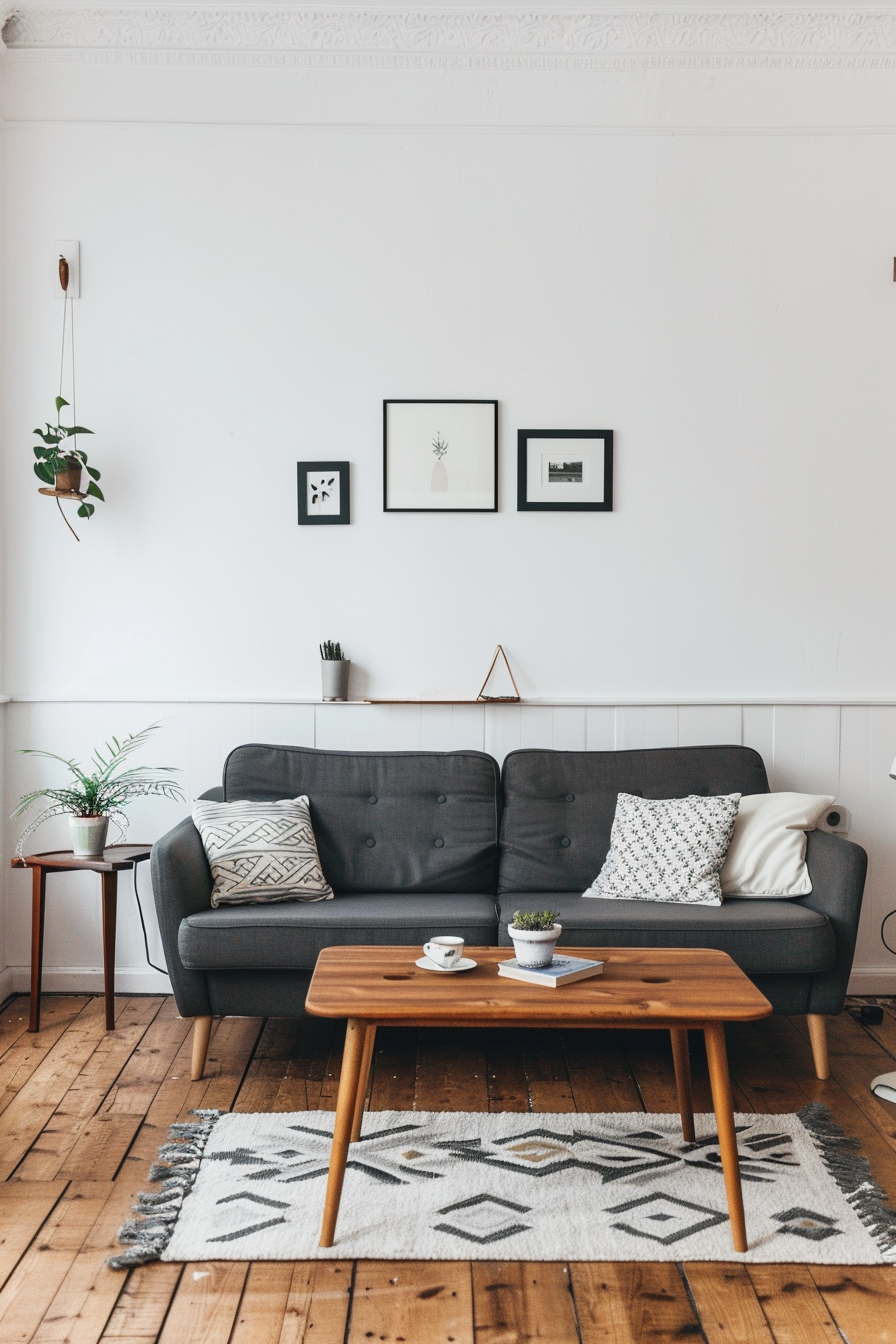
11. Create a Cozy and Moody Atmosphere
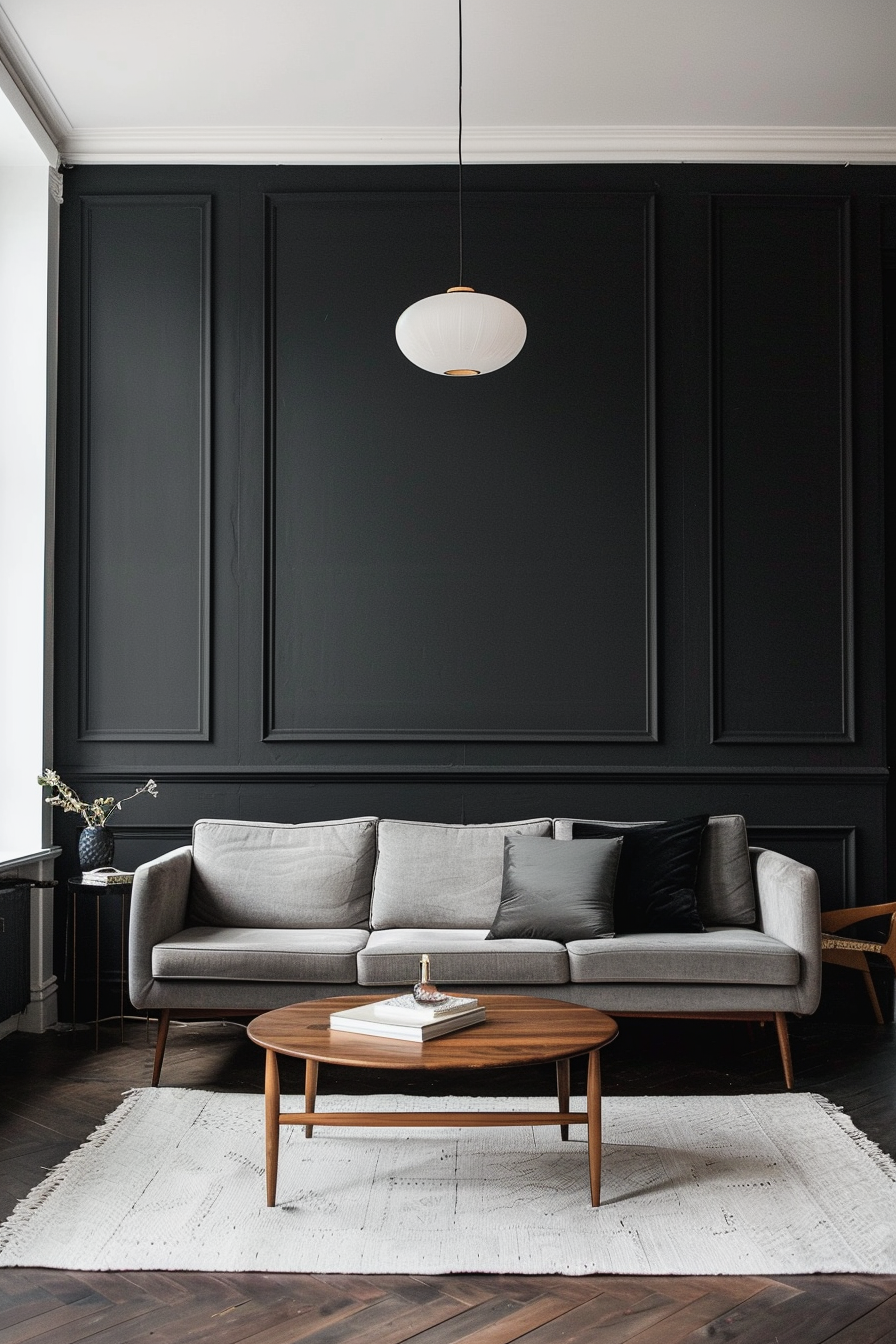
While organic modern design often leans towards light and airy spaces, there’s also room for creating a cozy and moody atmosphere. This can be achieved through darker color palettes, rich textures, and layered lighting. These elements can make the living room feel intimate and inviting.
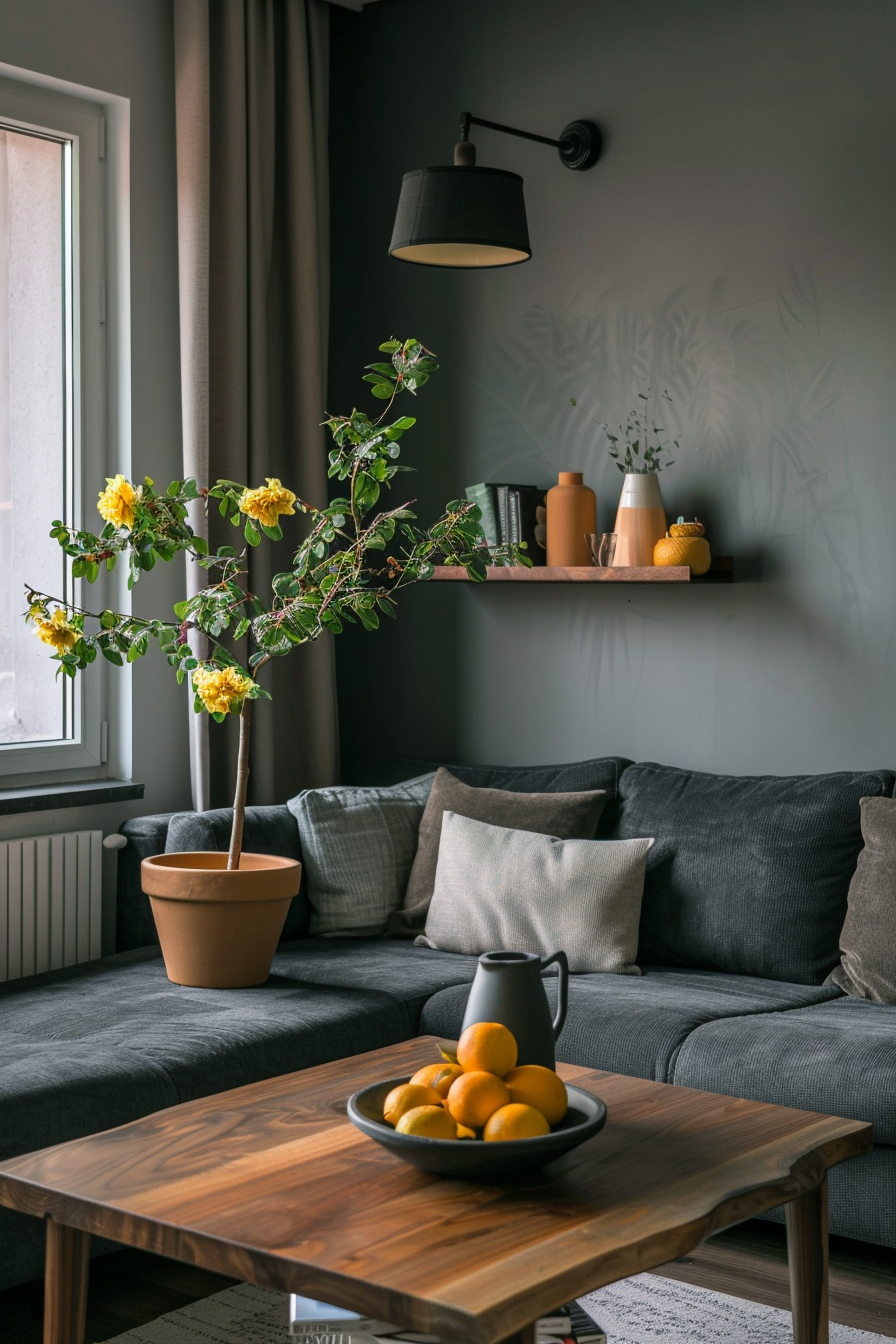
Choose deep, earthy colors for accents or walls to add warmth and depth. Darker shades like charcoal, forest green, or navy can create a dramatic backdrop for lighter furnishings and decor. These colors work well in smaller spaces by making them feel cozy rather than confined.
Use textured fabrics and materials to enhance the moody vibe. Velvet cushions, wool throws, and dark wood furniture can add richness and comfort. Complement these with layered lighting, such as floor lamps and wall sconces, to create pockets of light and shadow that enhance the room’s ambiance.
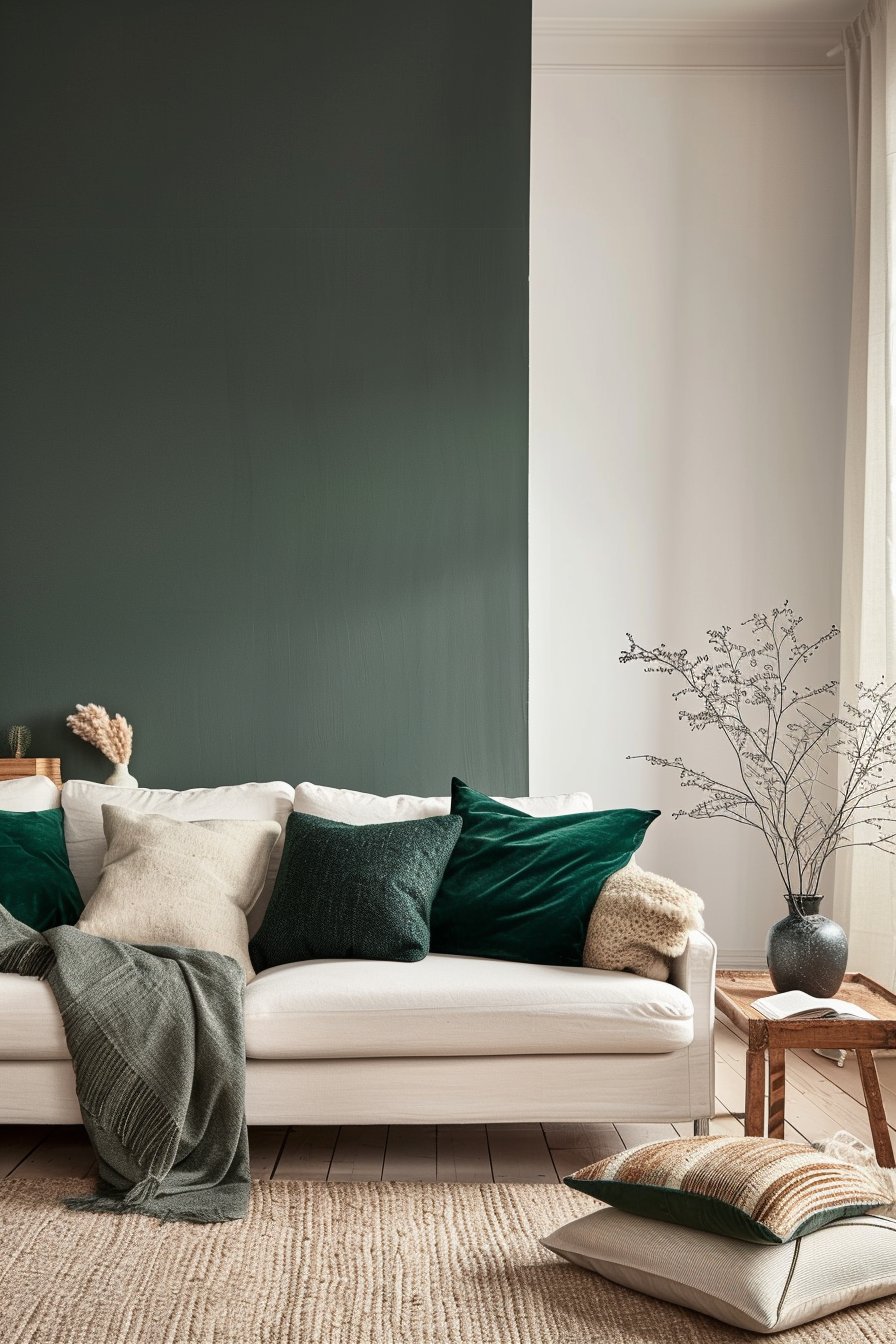
12. Optimize for Small Spaces
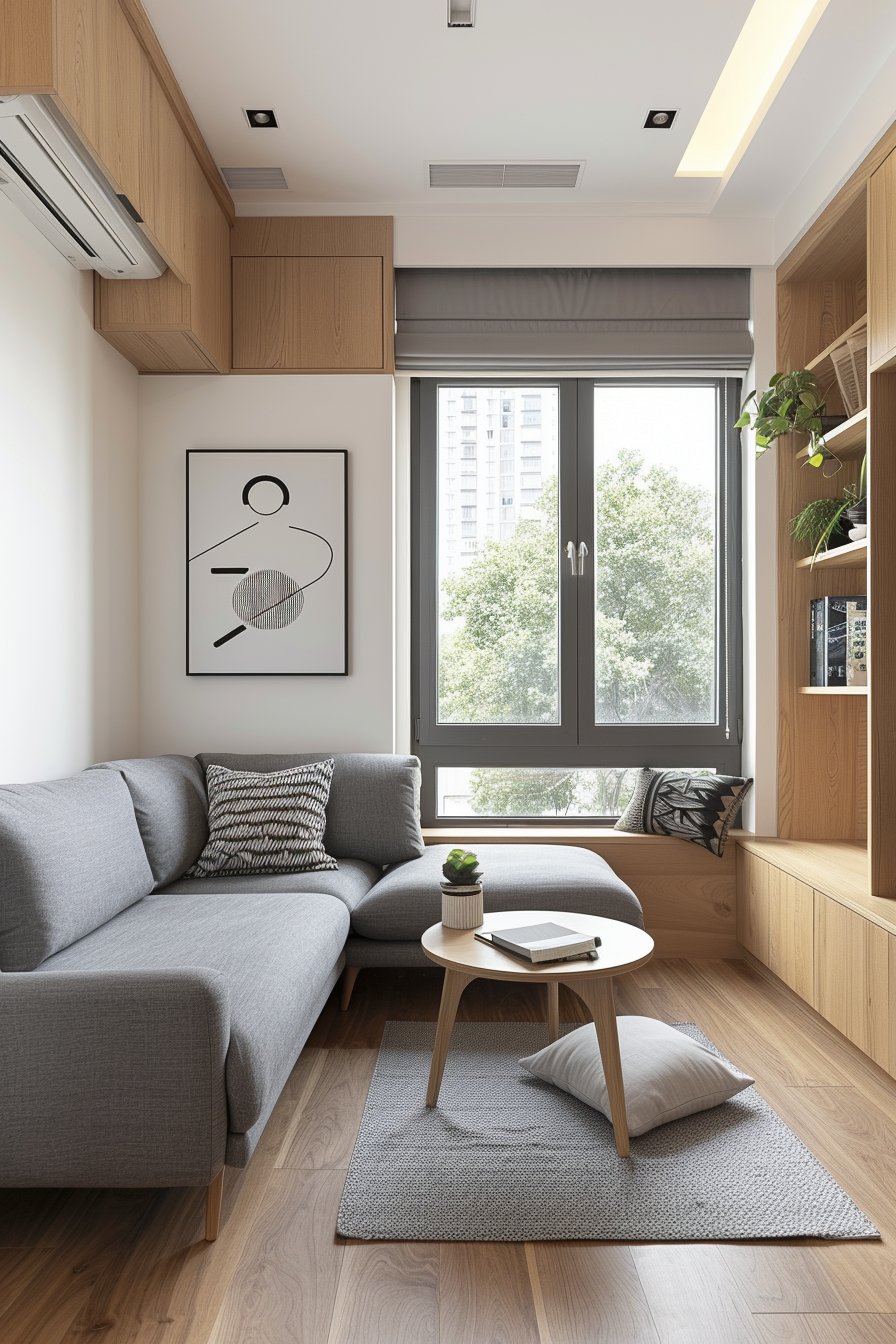
Designing for small spaces can be challenging, but with the right approach, you can create an organic modern living room that feels open and functional. Focus on multi-purpose furniture and smart storage solutions to maximize the available space. Avoid overcrowding the room with too many pieces or oversized furniture.
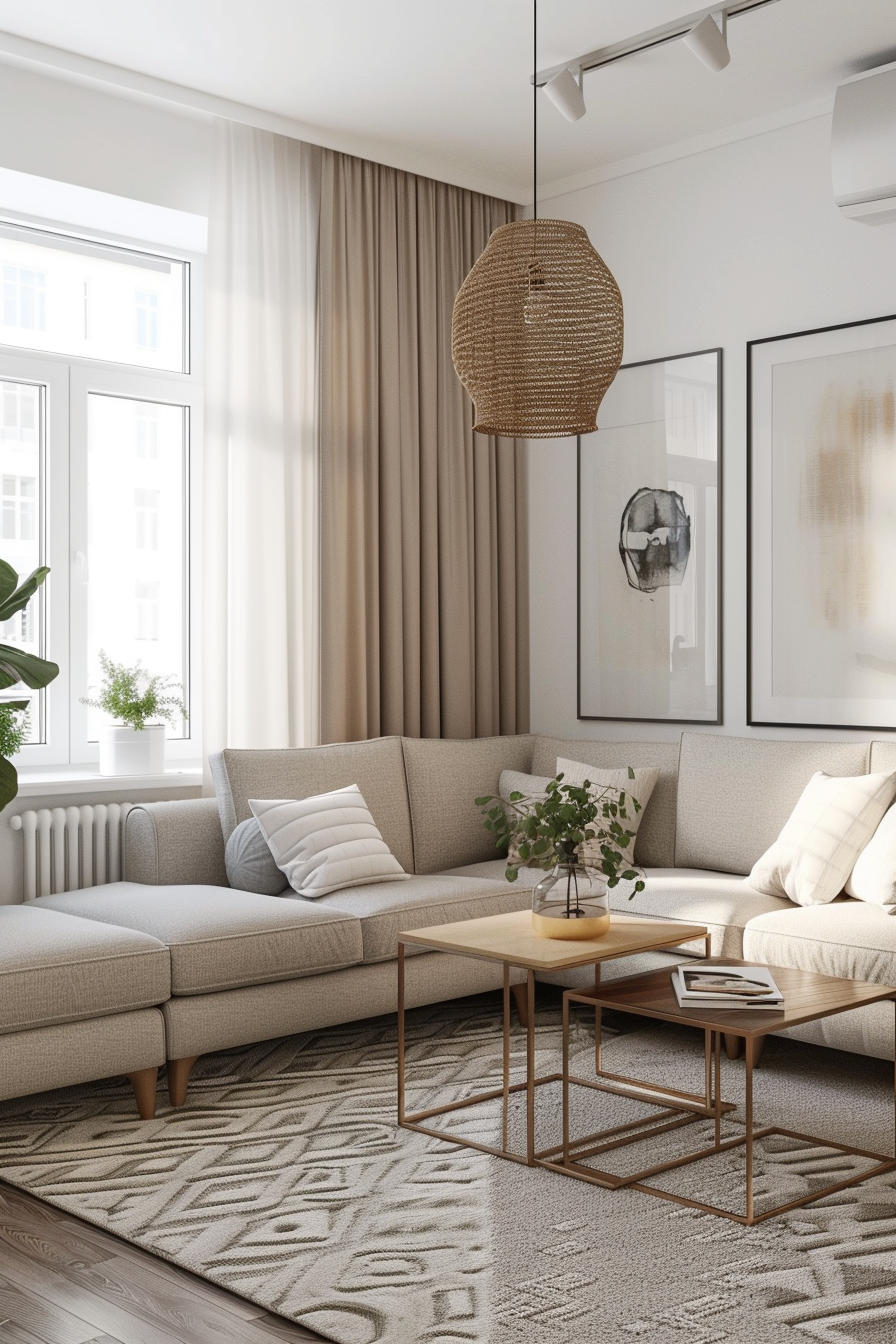
Choose furniture that fits the scale of your space. A small, sleek couch or a set of compact armchairs can provide ample seating without overwhelming the room. Look for pieces that offer storage, such as ottomans with hidden compartments or coffee tables with shelves.
Use vertical space to your advantage by adding shelves or wall-mounted storage. This helps keep the floor clear and makes the room feel more spacious. Incorporate light colors and reflective surfaces to enhance the sense of openness and create a bright, airy atmosphere.
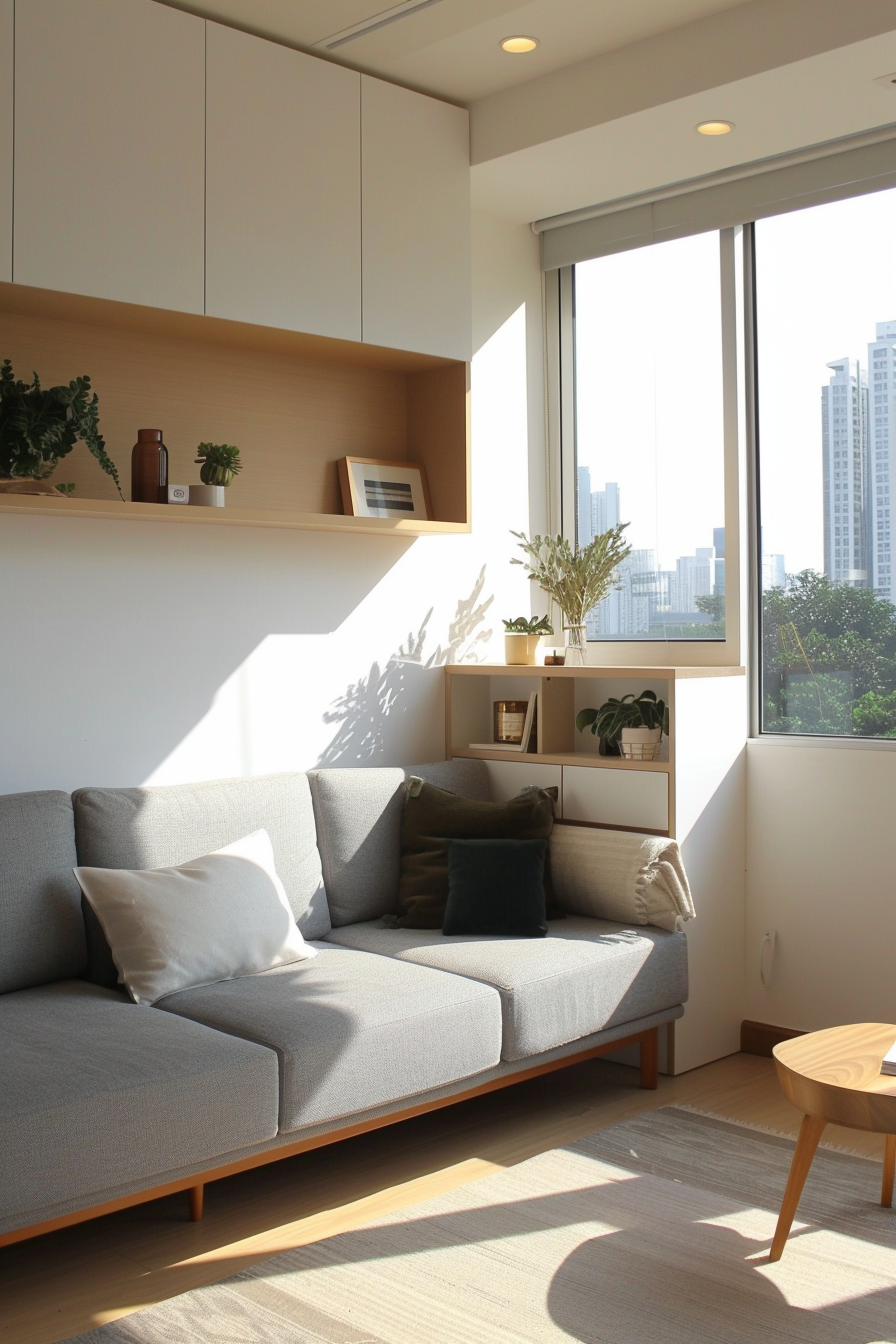
13. Balance Comfort and Style
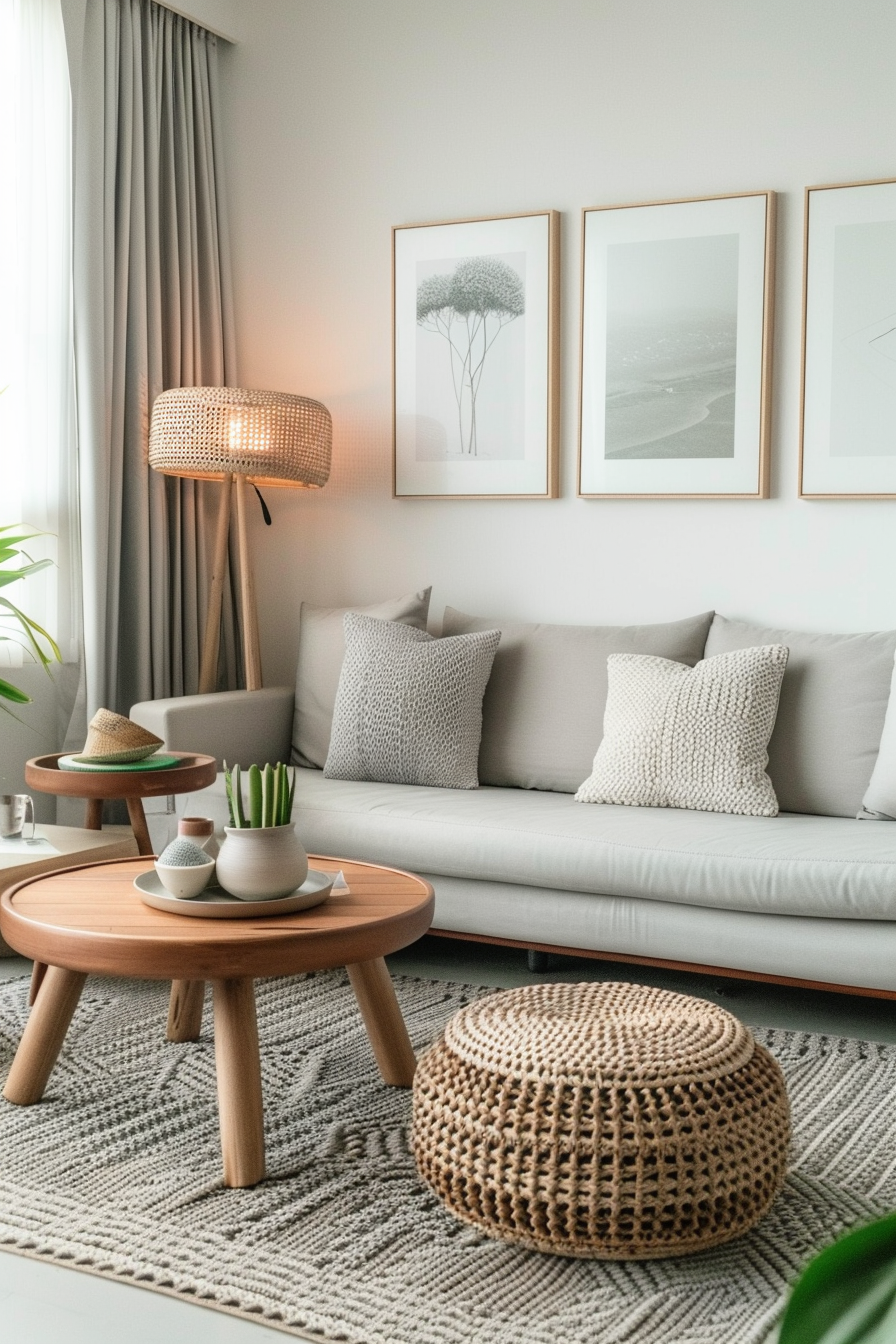
Achieving the right balance between comfort and style is essential in an organic modern living room. The space should feel inviting and comfortable while maintaining a clean, contemporary aesthetic. Choose furniture and decor that offer both visual appeal and practical comfort.
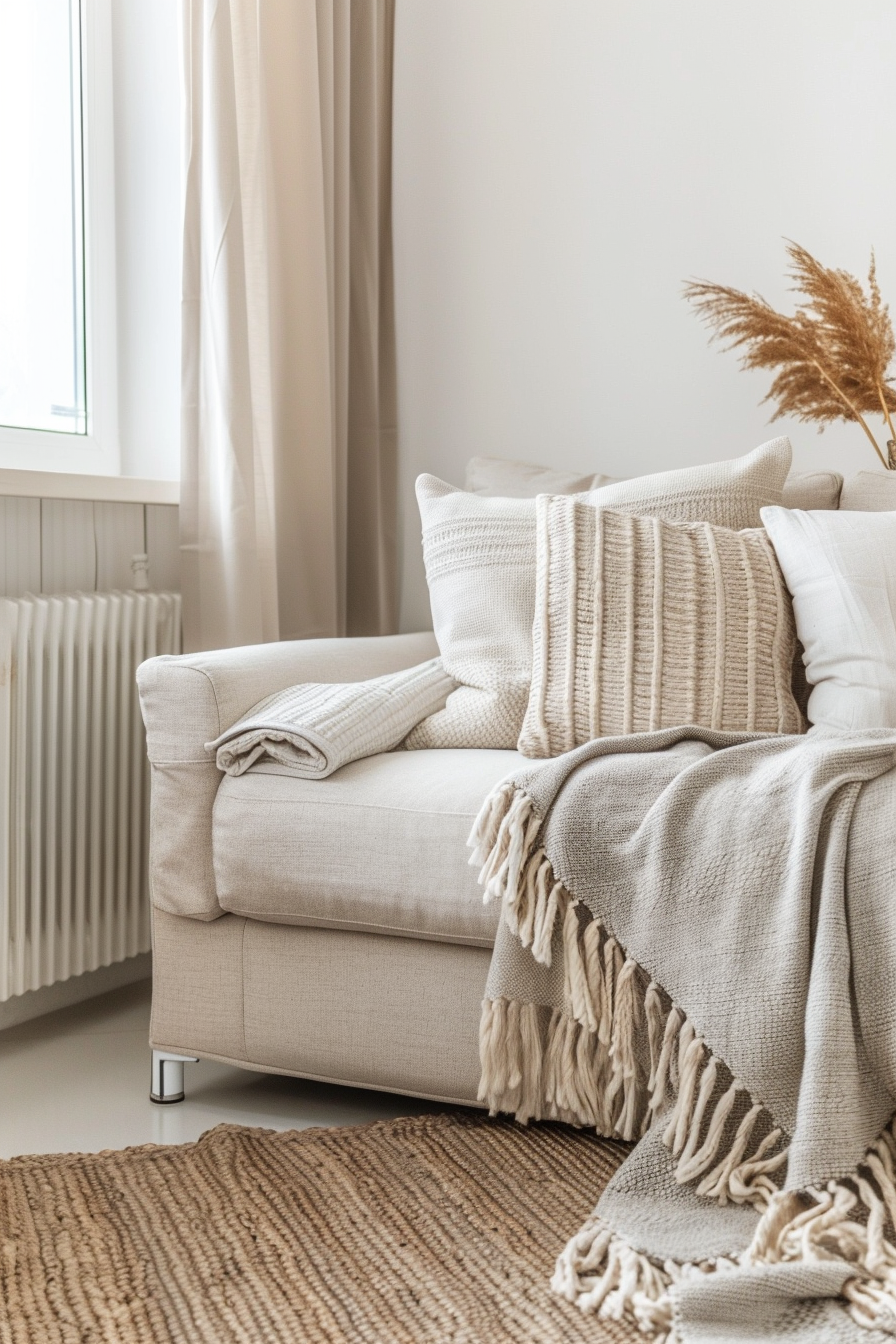
Start with a comfortable couch or seating area as the room’s centerpiece. Opt for designs with clean lines and soft cushions that provide support and coziness. Complement this with plush rugs, throw pillows, and blankets that add layers of warmth and texture.
Incorporate stylish yet functional decor, such as side tables, lighting, and storage solutions that enhance the room’s aesthetic. Look for pieces that blend seamlessly with the overall design while offering practical benefits. This approach ensures your living room is a space where you can relax and enjoy.
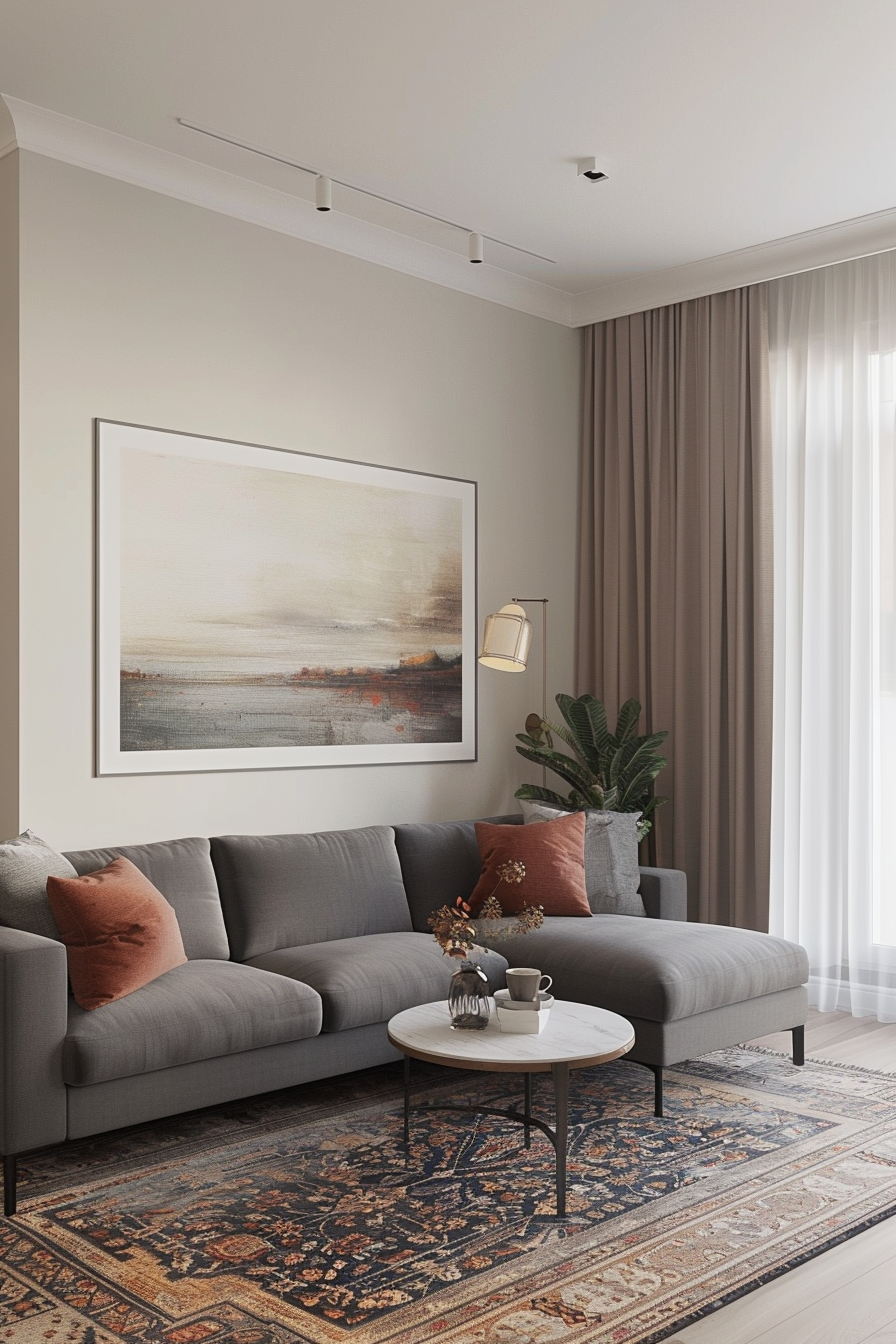
14. Integrate Earthy Elements
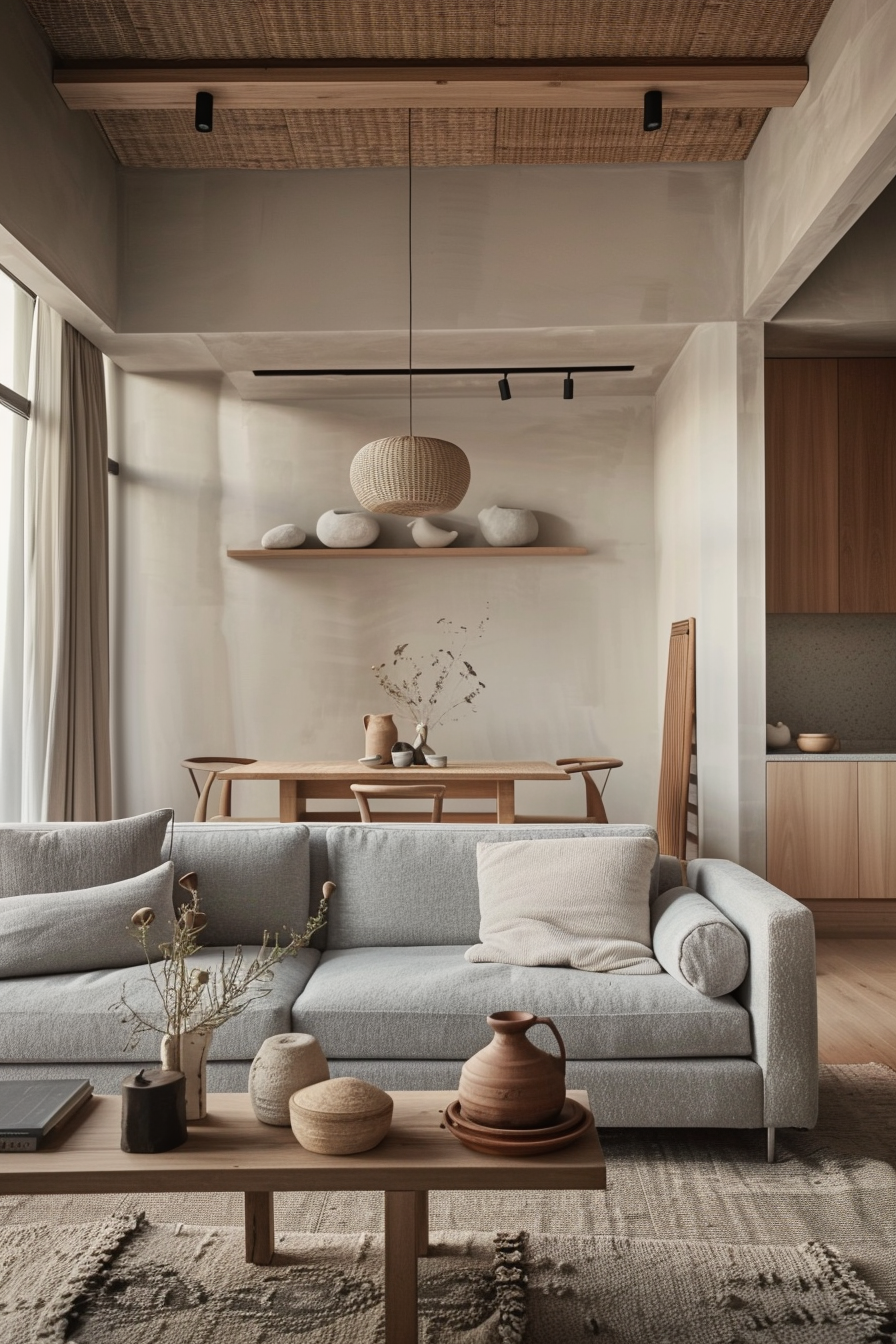
Earthy elements are a cornerstone of the organic modern style, adding warmth and grounding the space. Incorporate natural materials like wood, stone, and clay to create a connection with the outdoors. These elements bring a tactile quality that enhances the room’s coziness and authenticity.
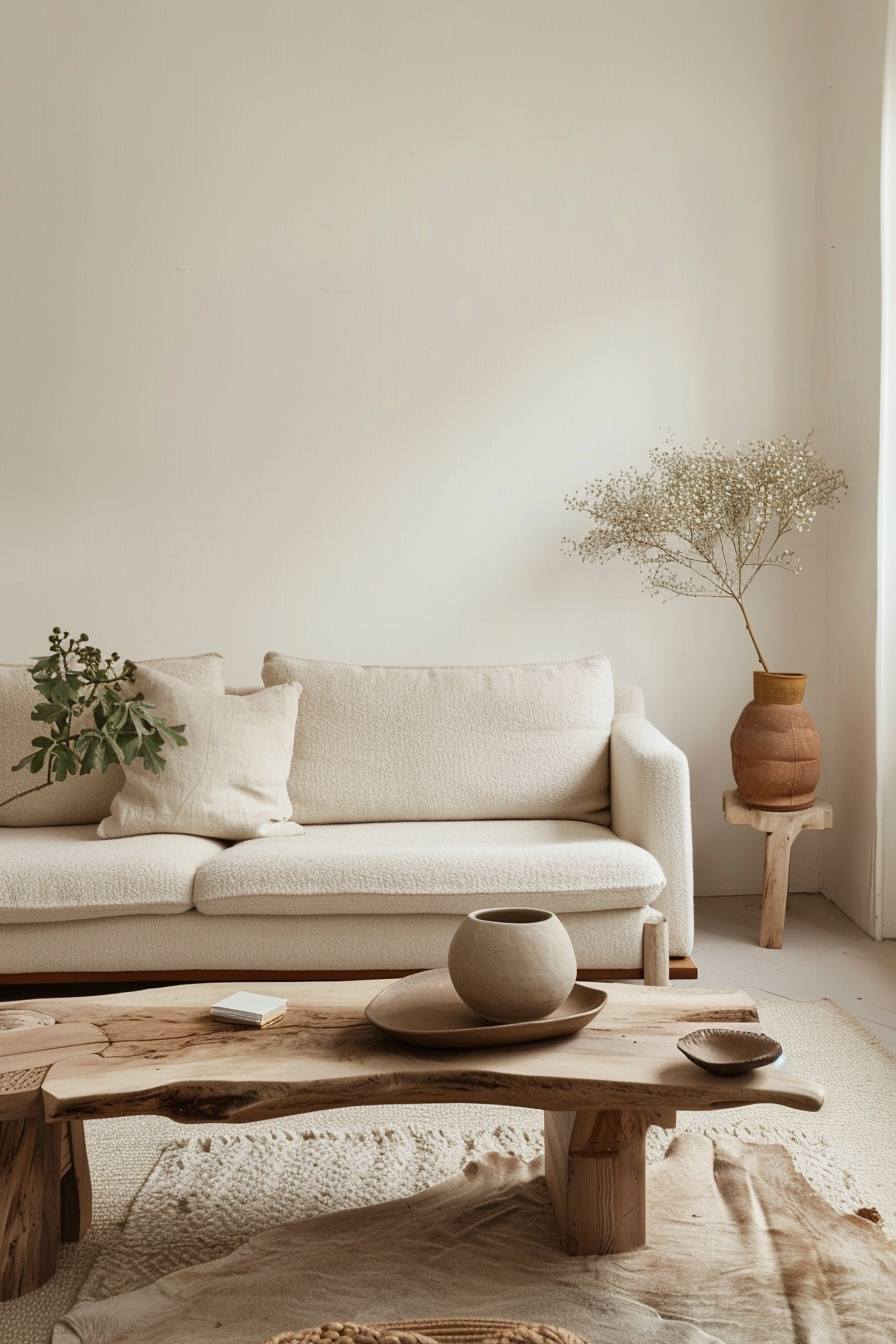
Wood is a versatile material that can be used in furniture, flooring, or decor. Opt for light or medium-toned woods to maintain a bright and airy feel. Stone accents, such as a coffee table or decorative objects, add texture and visual interest. Clay or ceramic items can introduce a handmade, artisanal touch.
Combine these materials with a neutral color palette to create a harmonious and balanced environment. The natural tones and textures will complement each other, resulting in a cohesive and inviting space that feels both stylish and grounded.
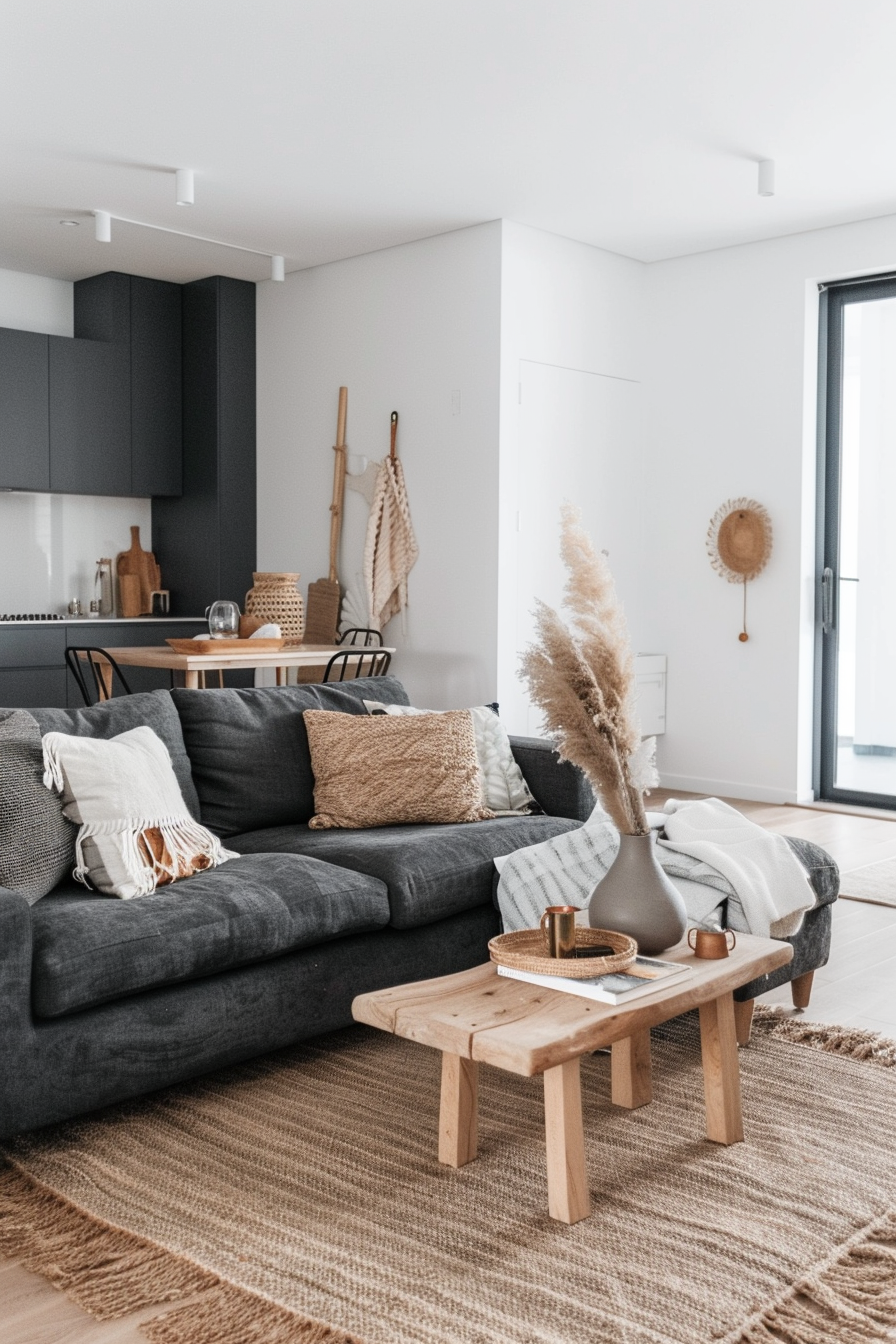
15. Find Your Personal Inspiration
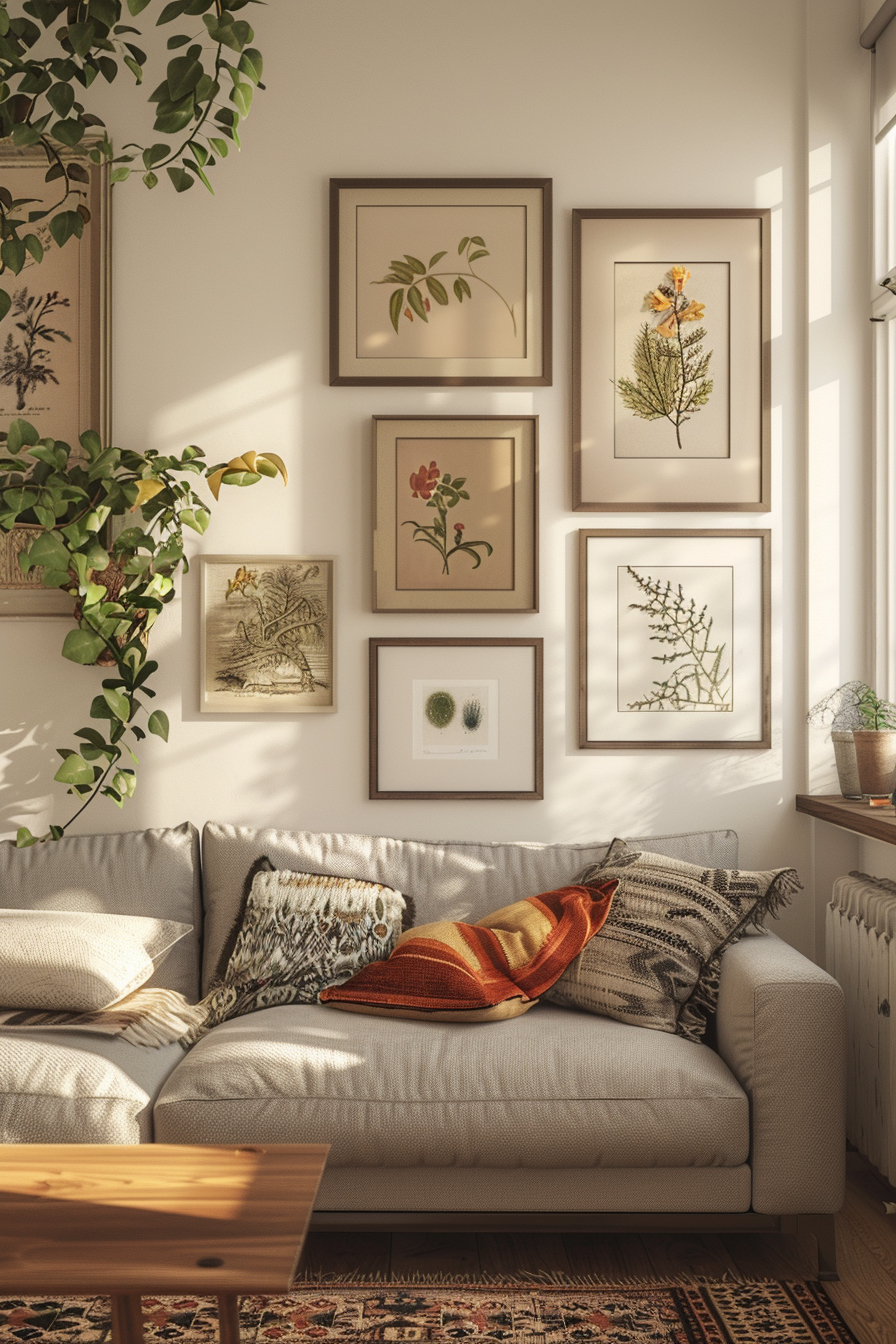
Creating an organic modern living room is about more than just following design rules; it’s about expressing your personal style and preferences. Draw inspiration from various sources, whether it’s nature, art, travel, or your own experiences. Incorporate elements that reflect who you are and make the space uniquely yours.
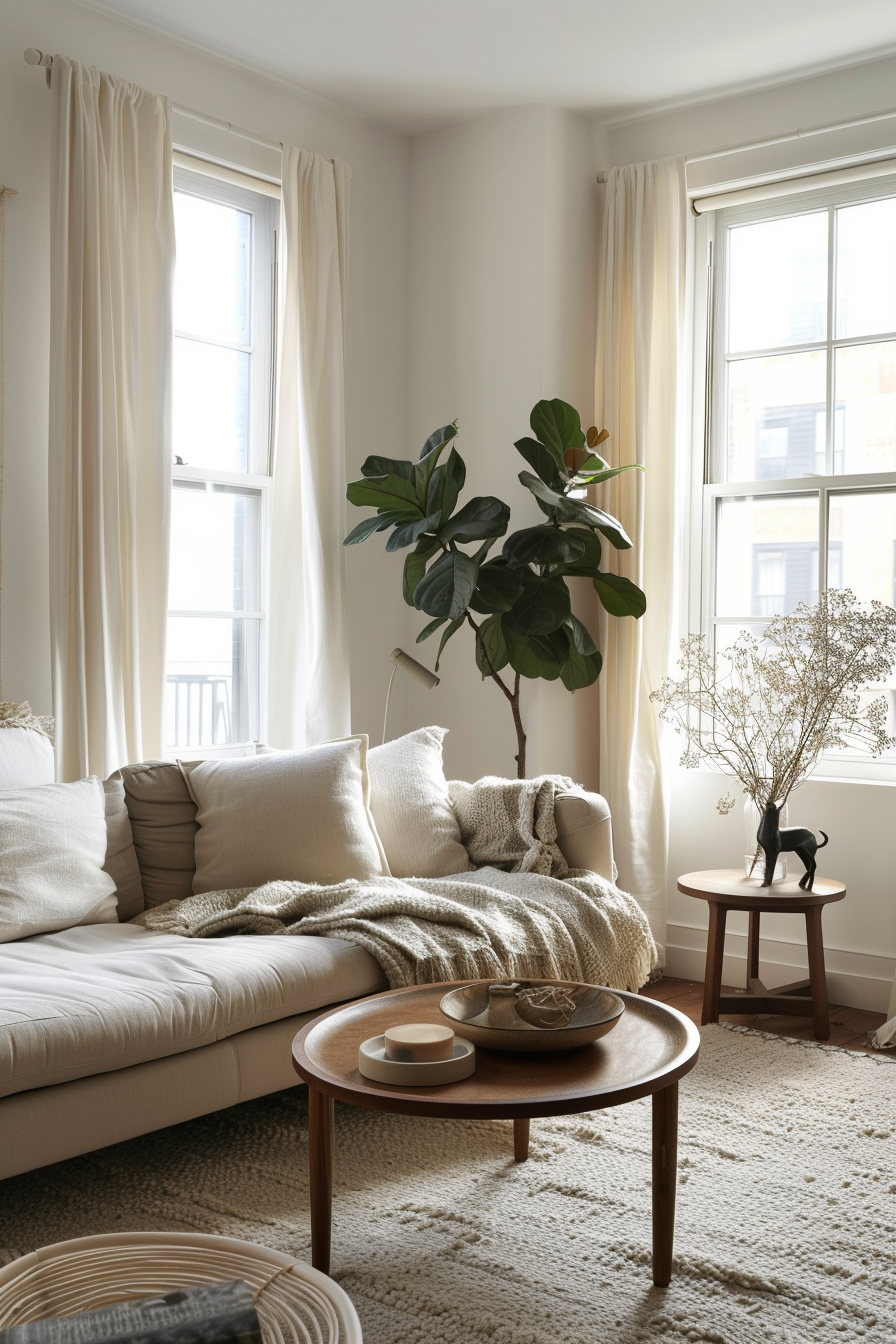
Start by identifying what aspects of organic modern design resonate with you the most. Do you love the simplicity of clean lines, the warmth of natural materials, or the tranquility of neutral colors? Use these as a foundation and build upon them with pieces that have personal significance.
Don’t be afraid to mix and match different styles and elements that speak to you. Whether it’s a vintage find, a piece of art, or a treasured object from your travels, these items can add character and make your living room feel like home. The goal is to create a space that not only looks beautiful but also feels authentic and meaningful.
